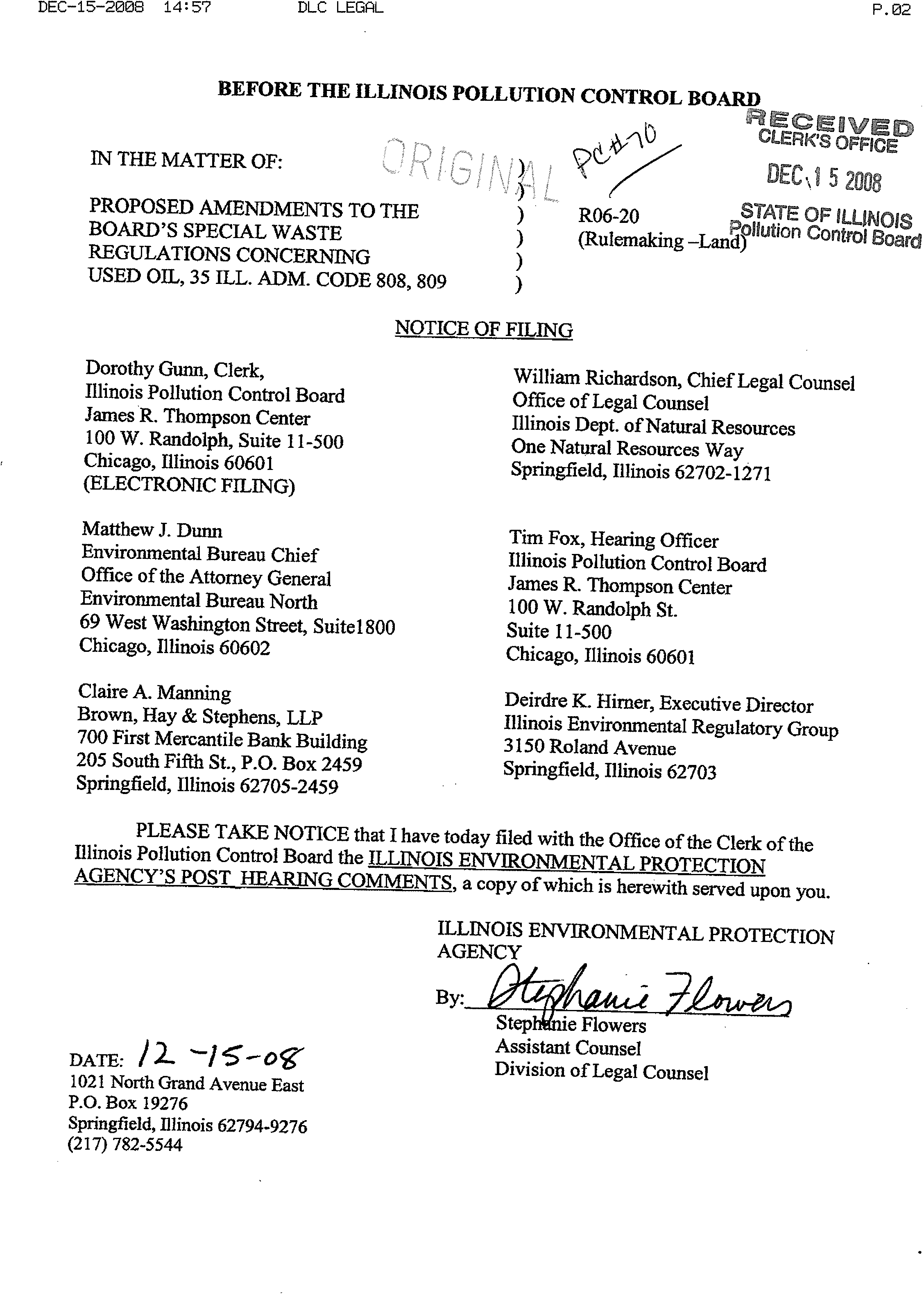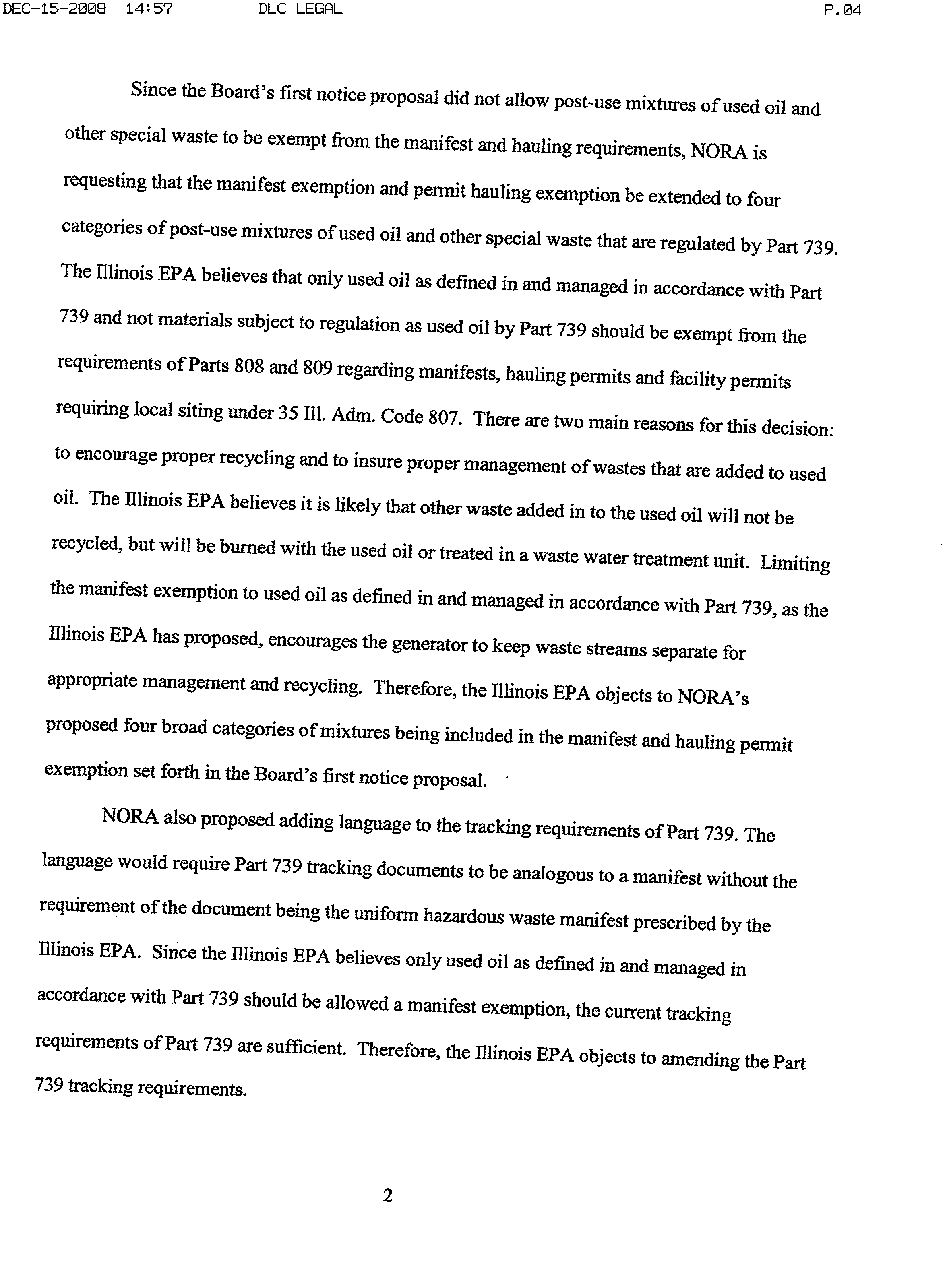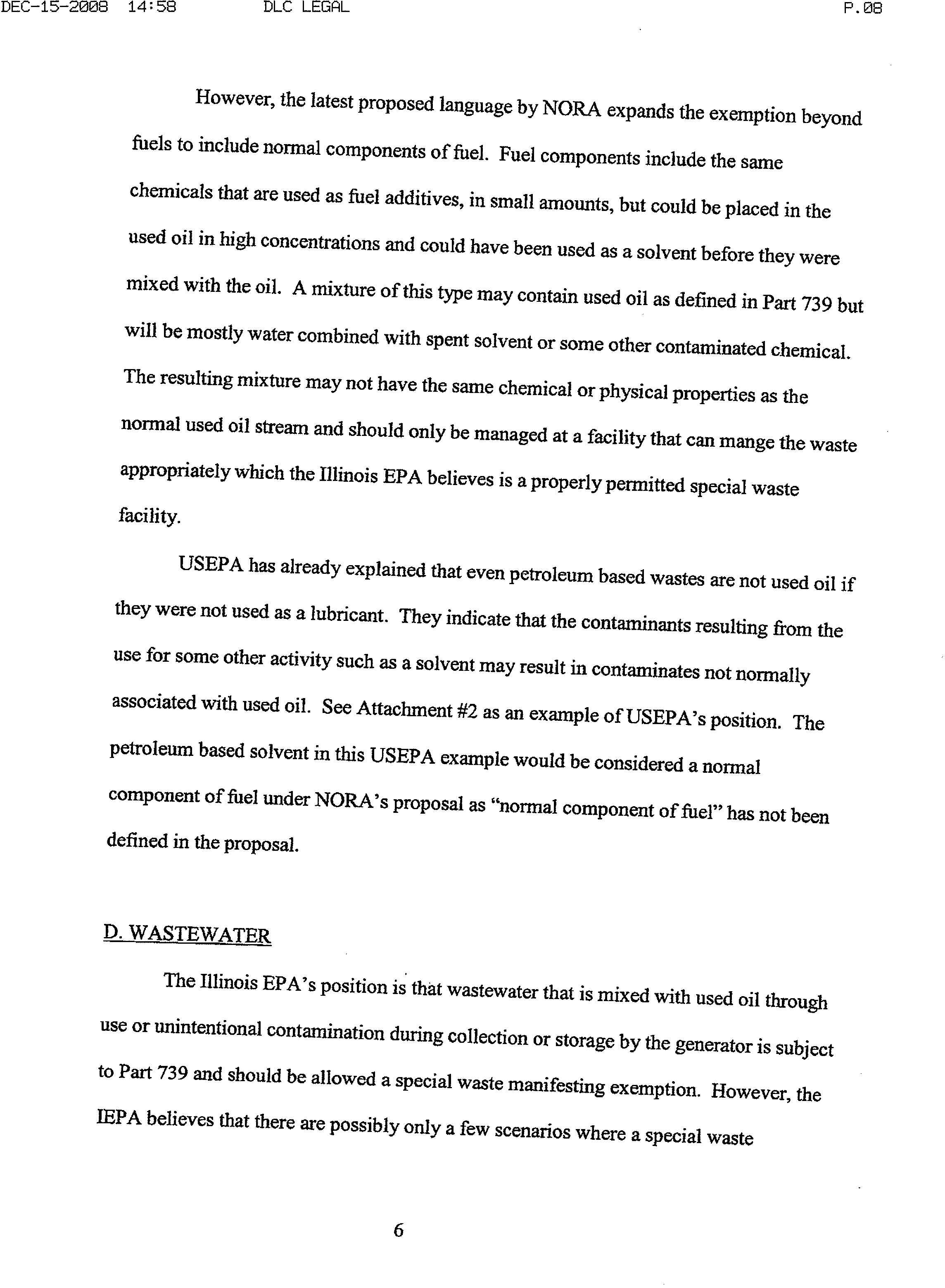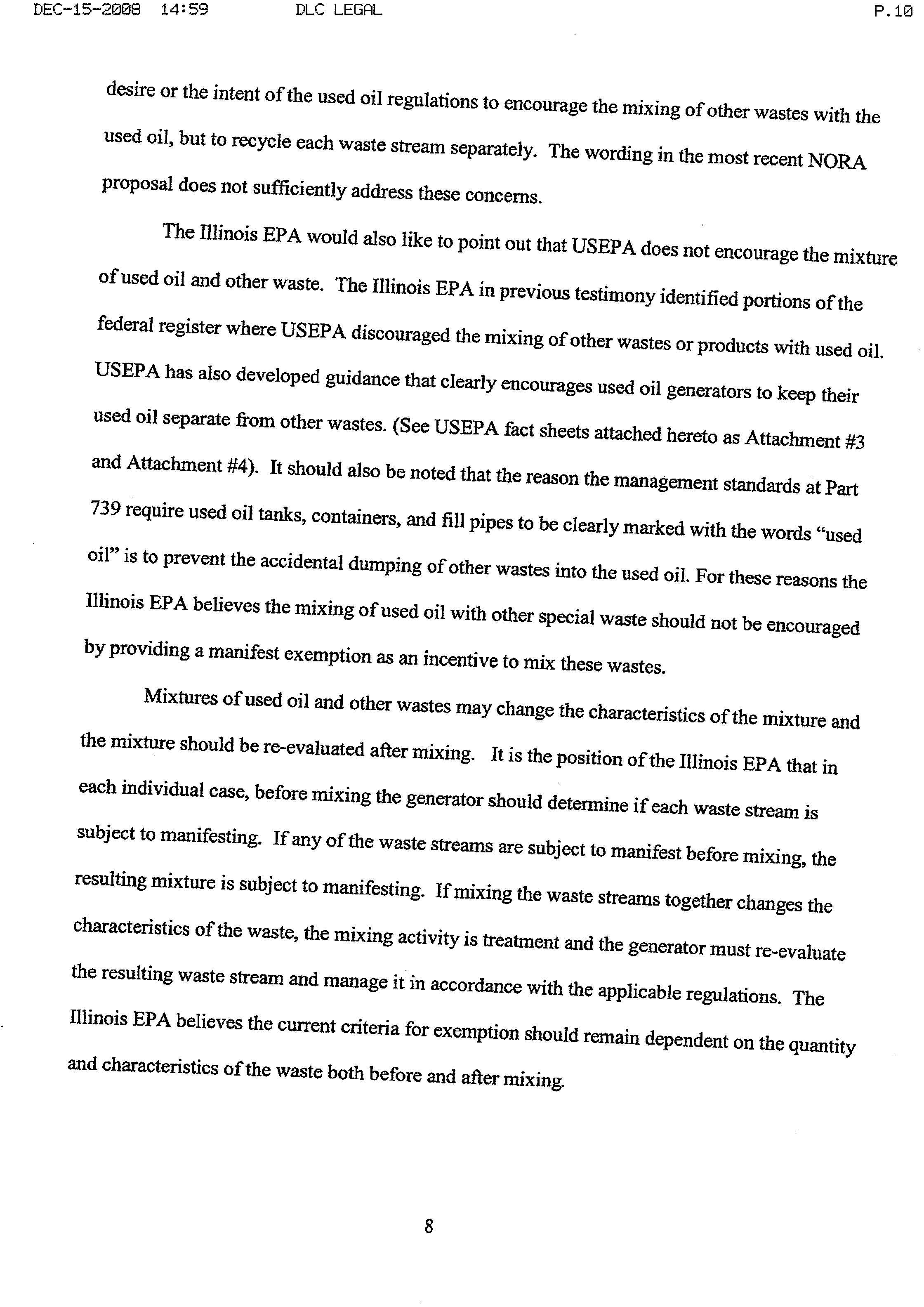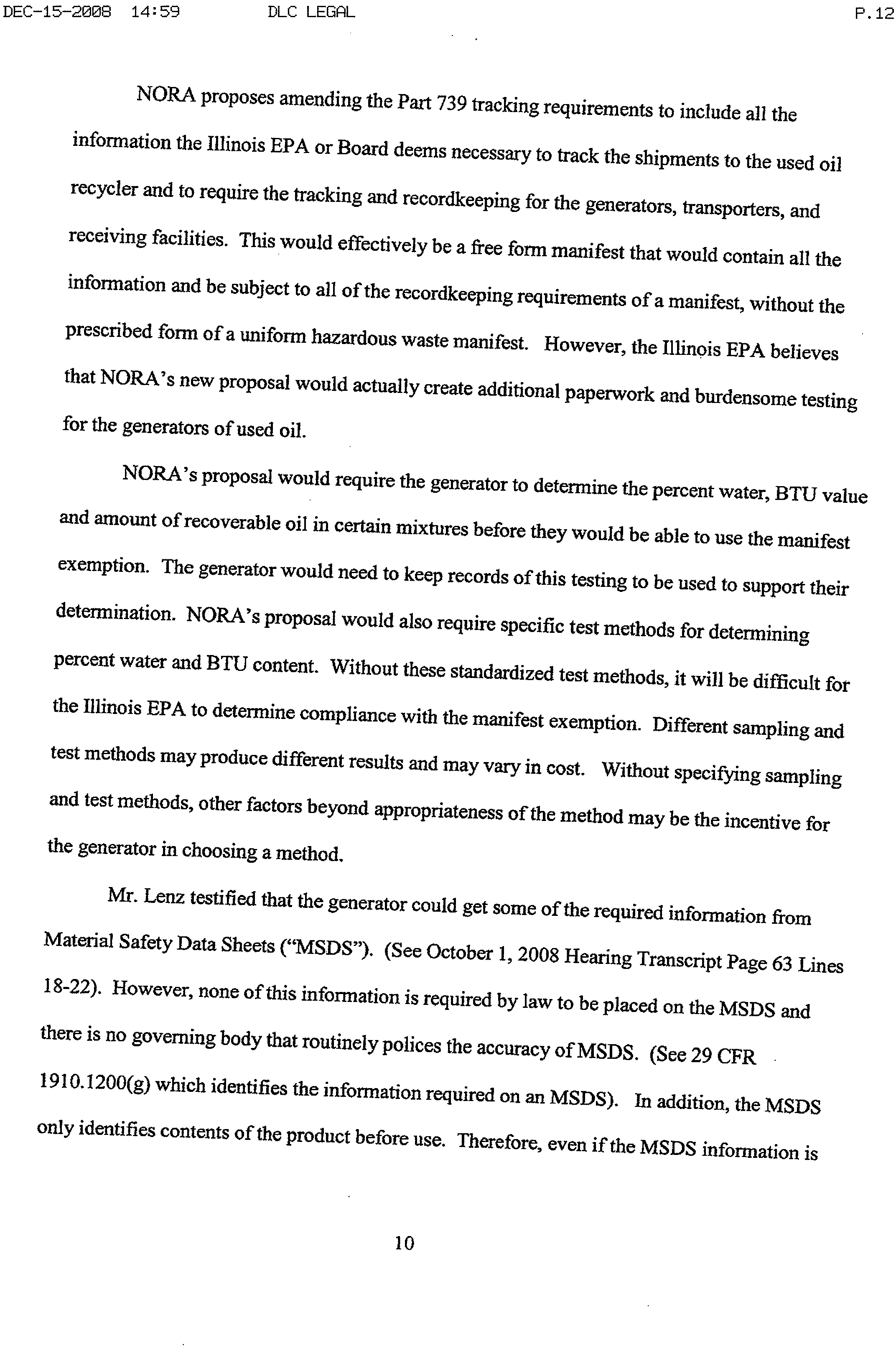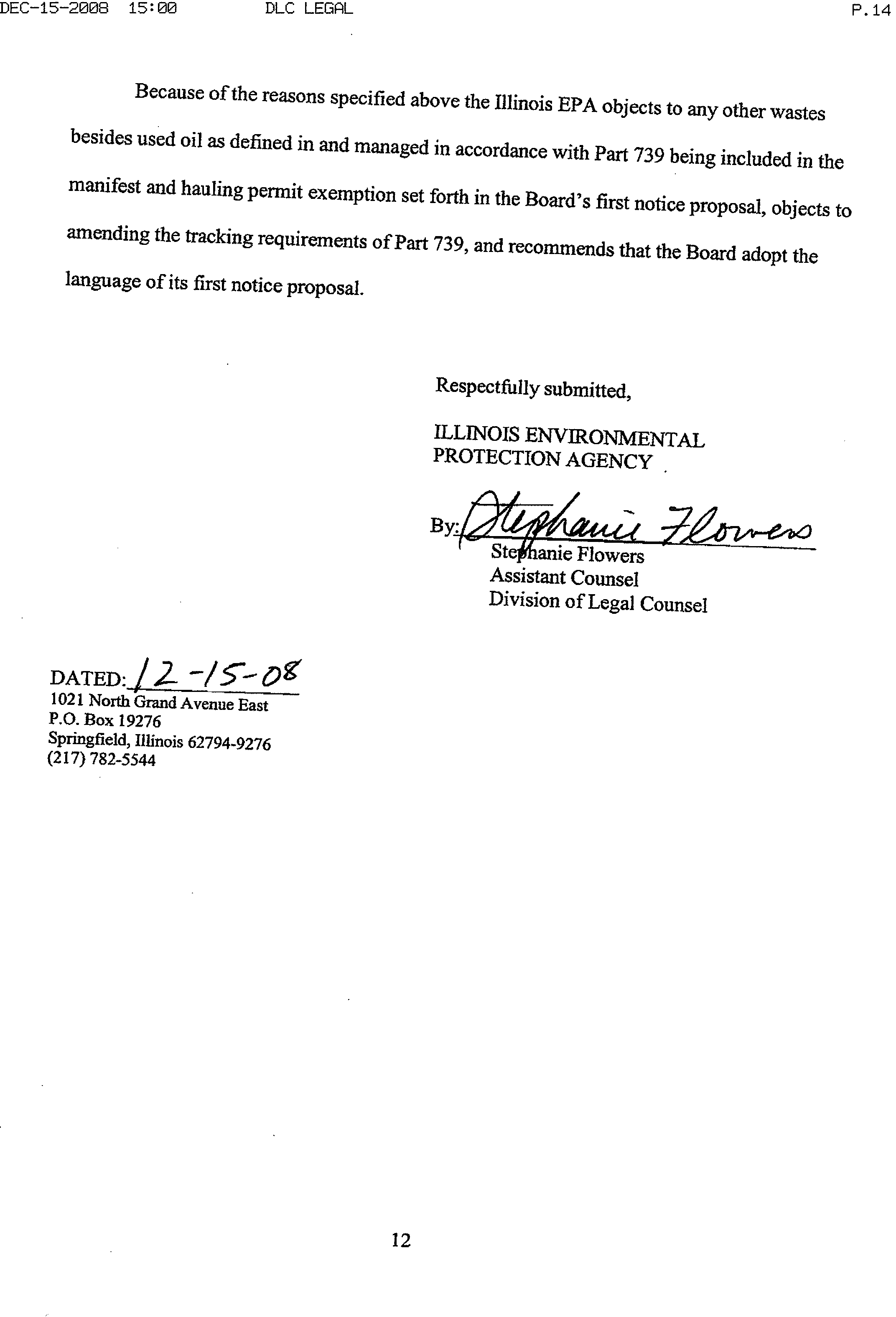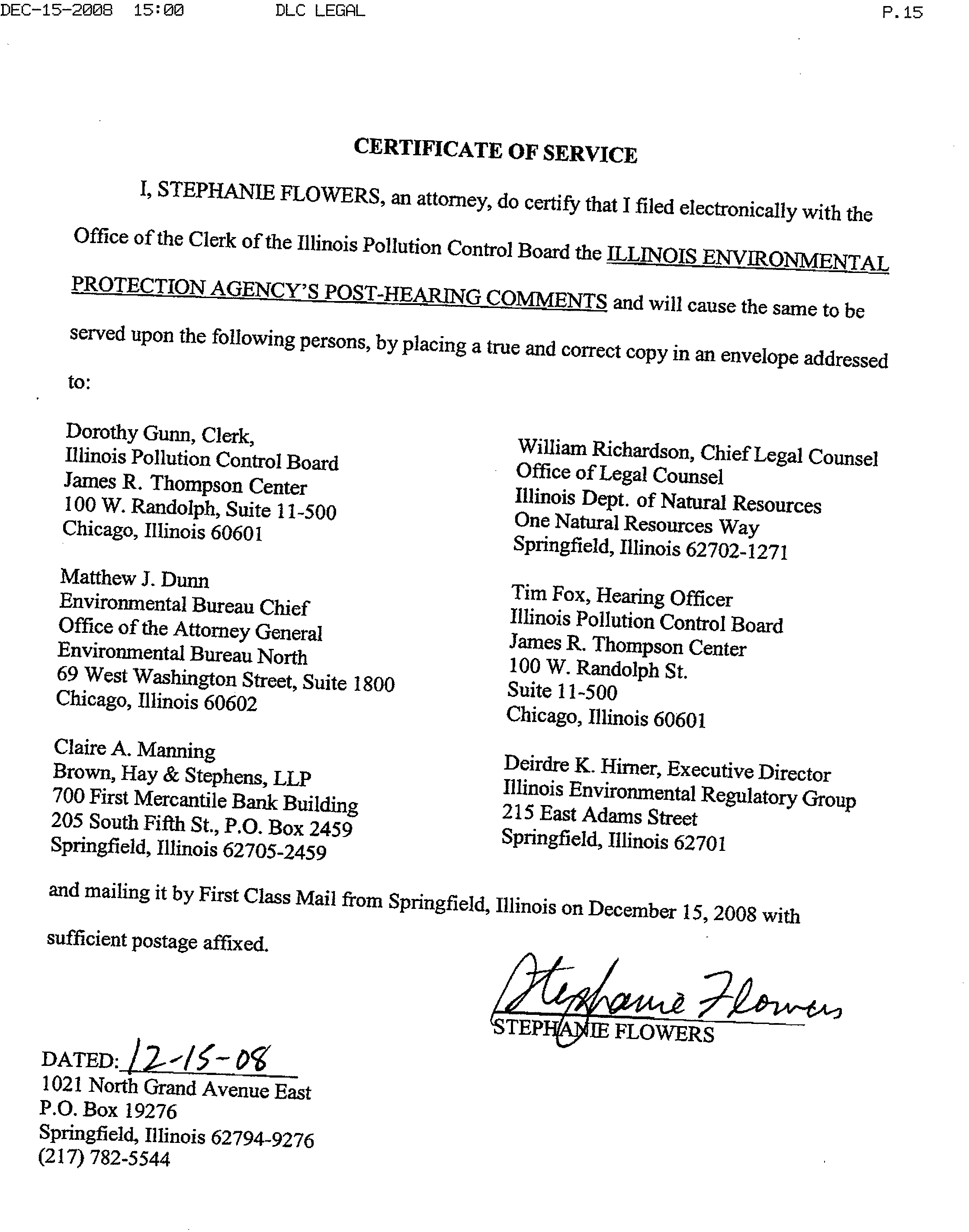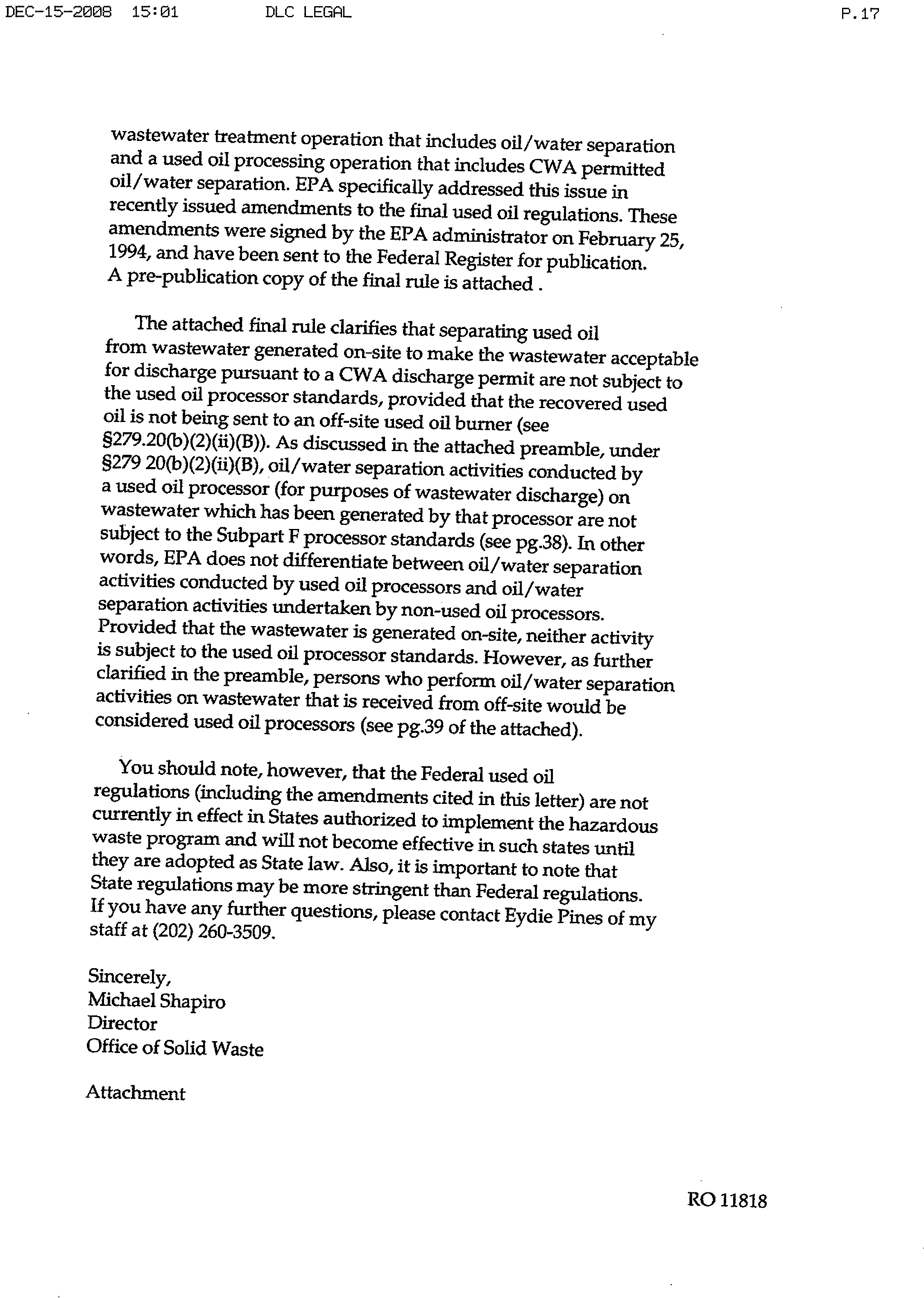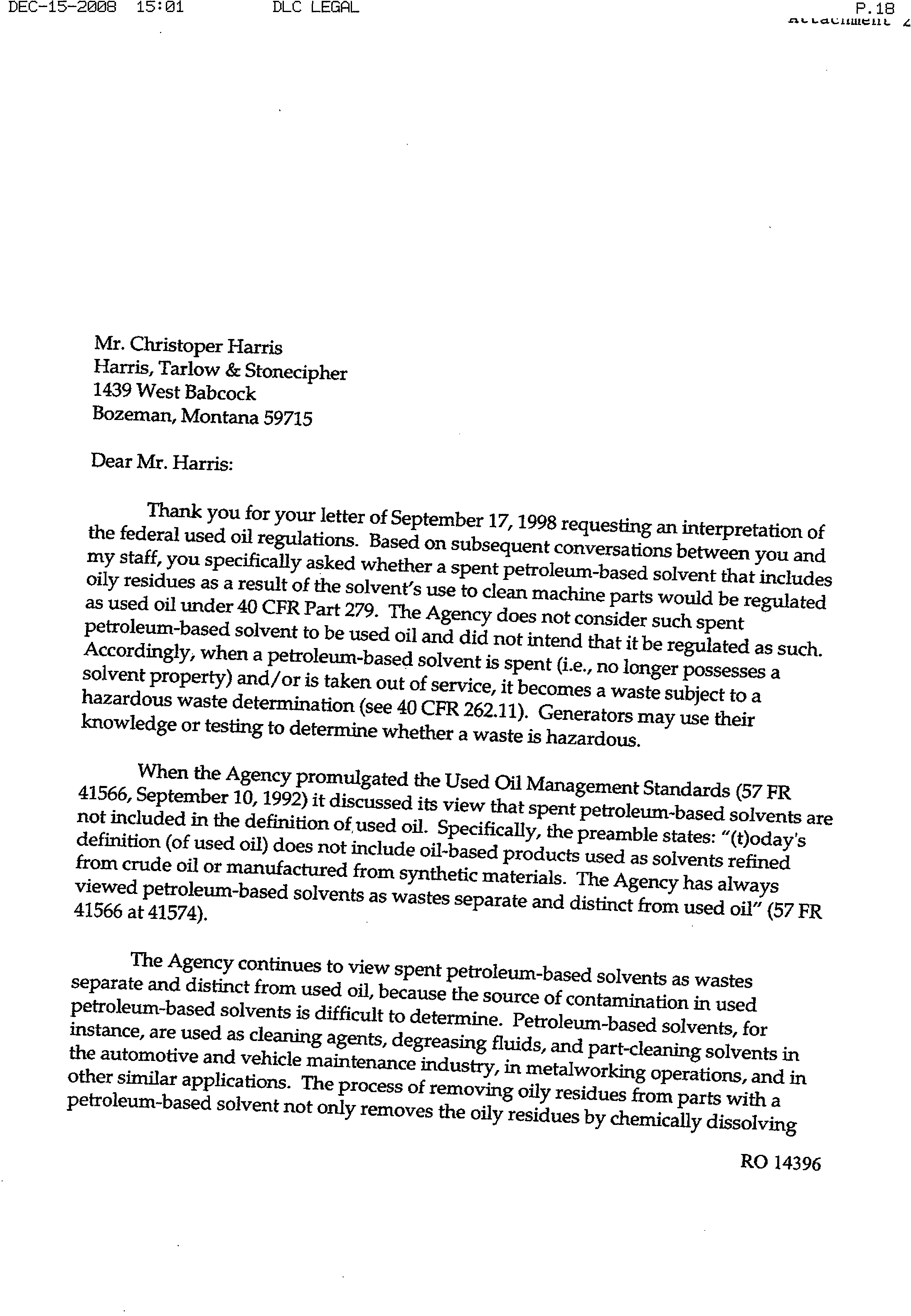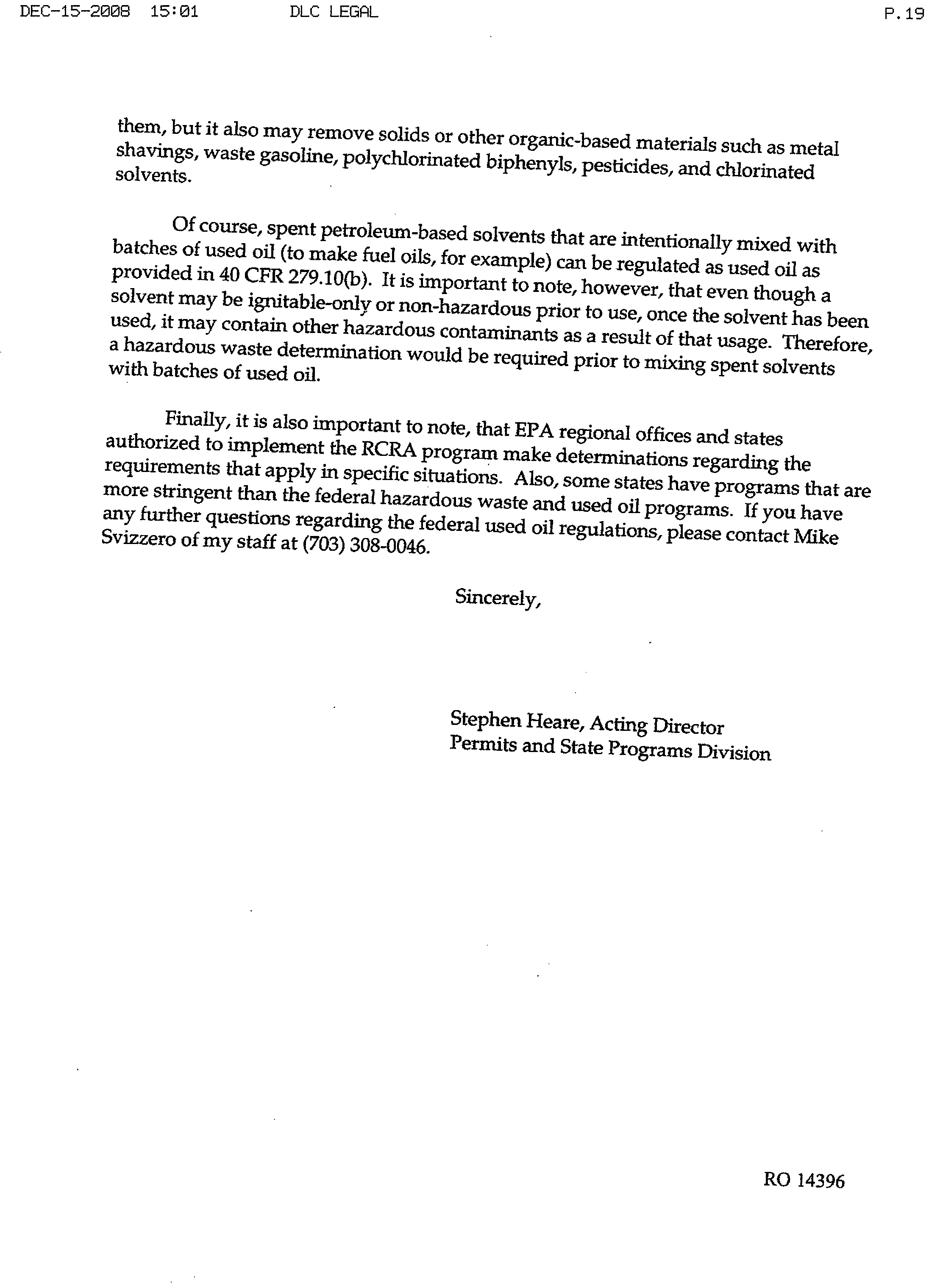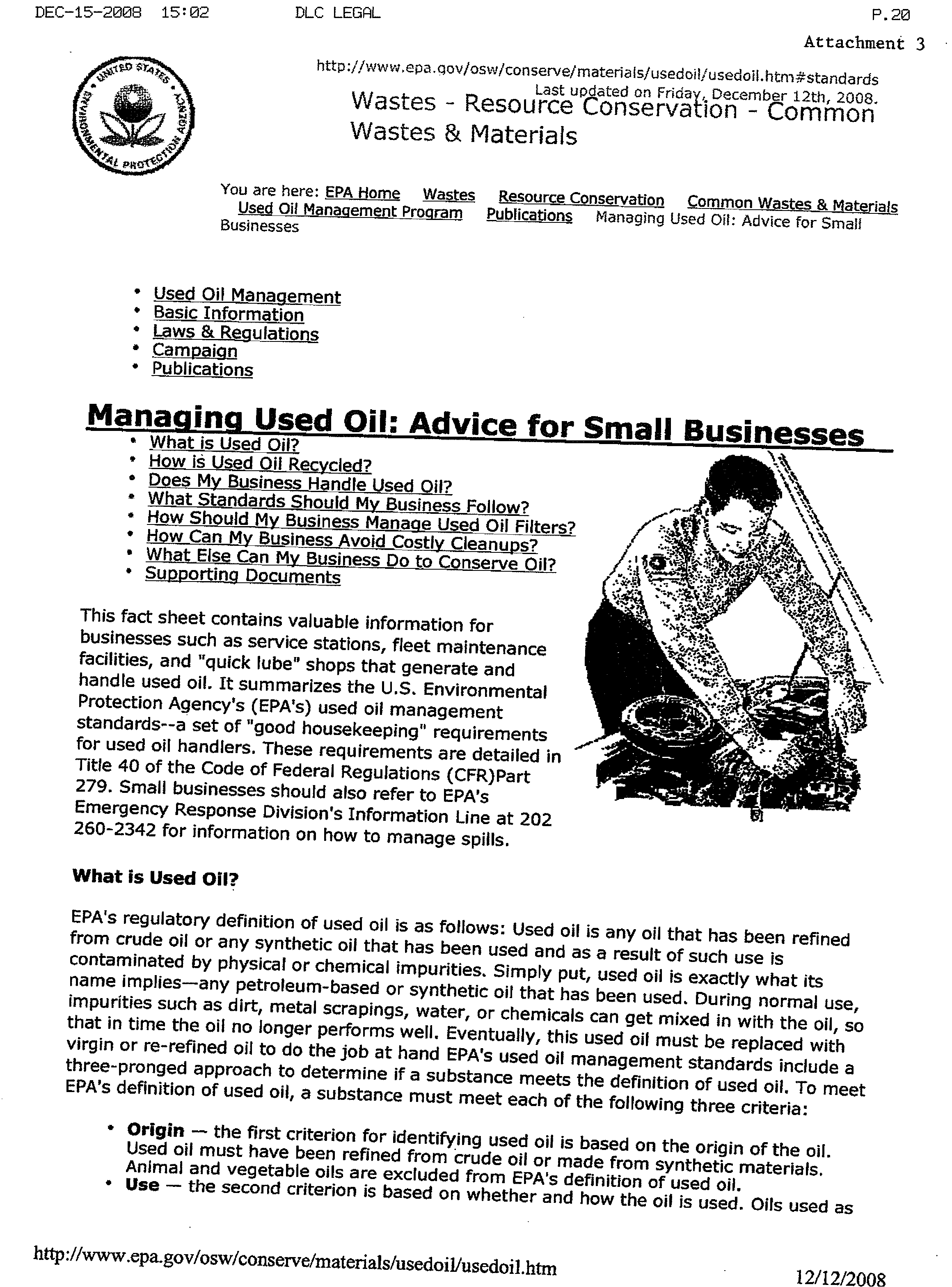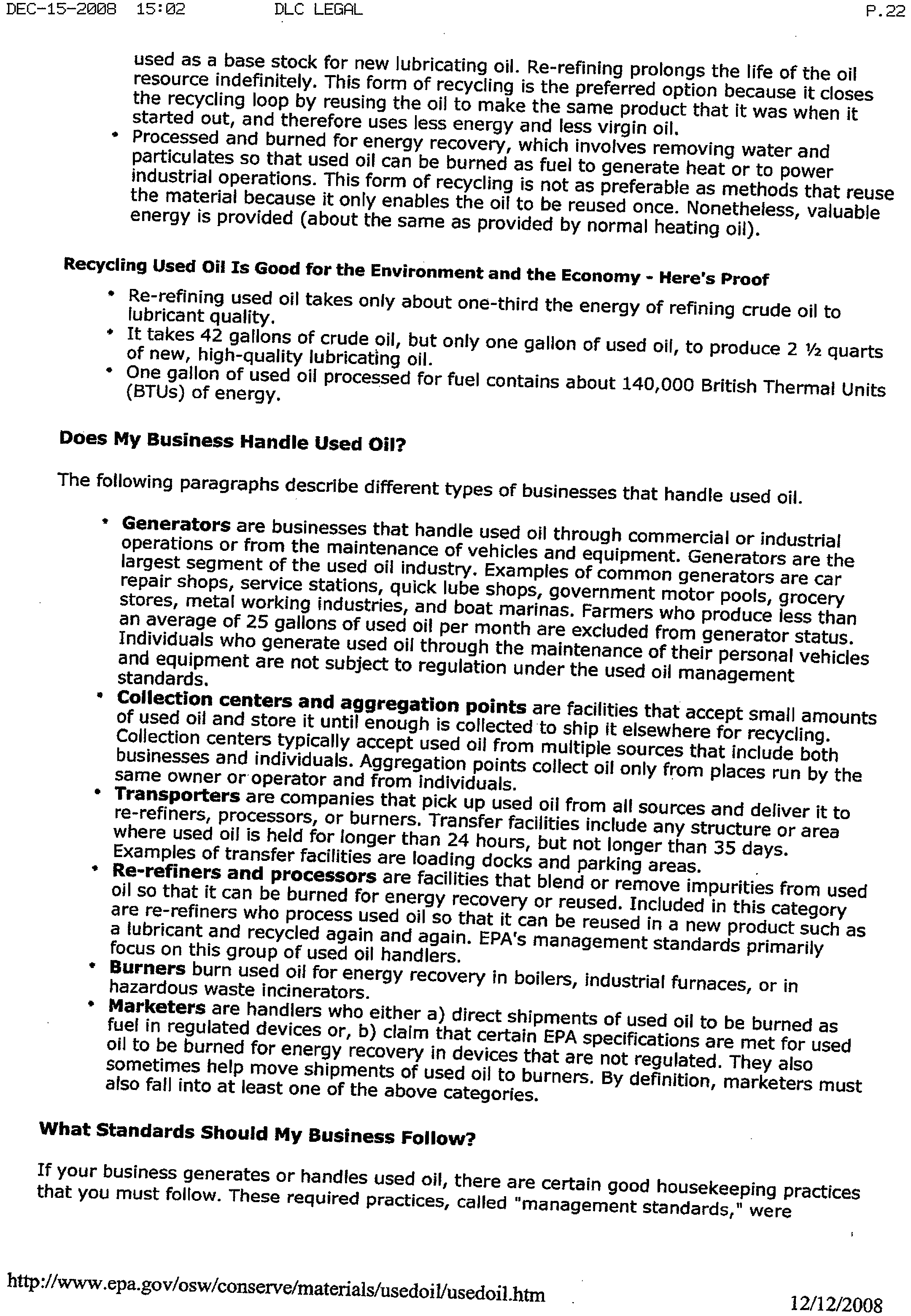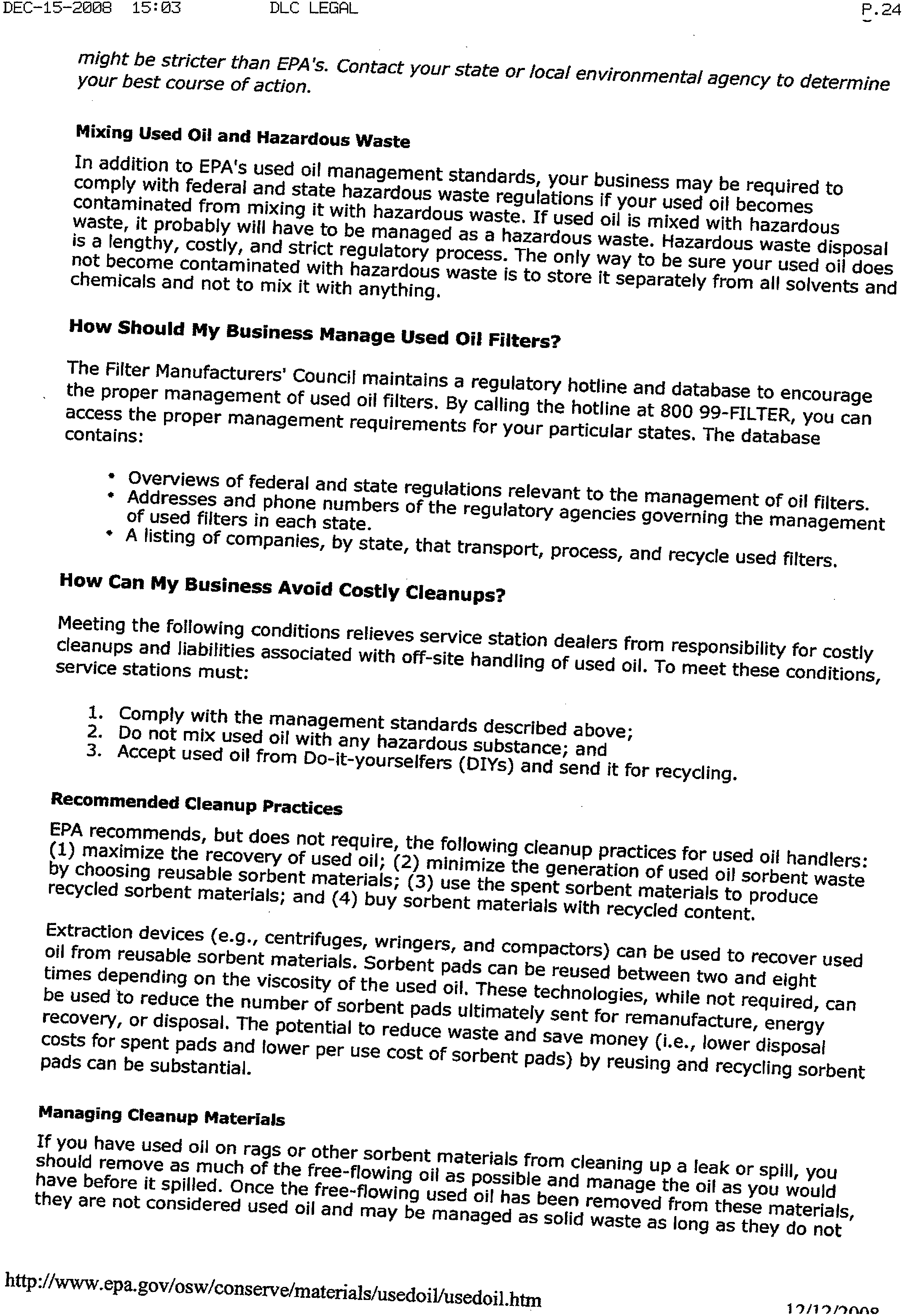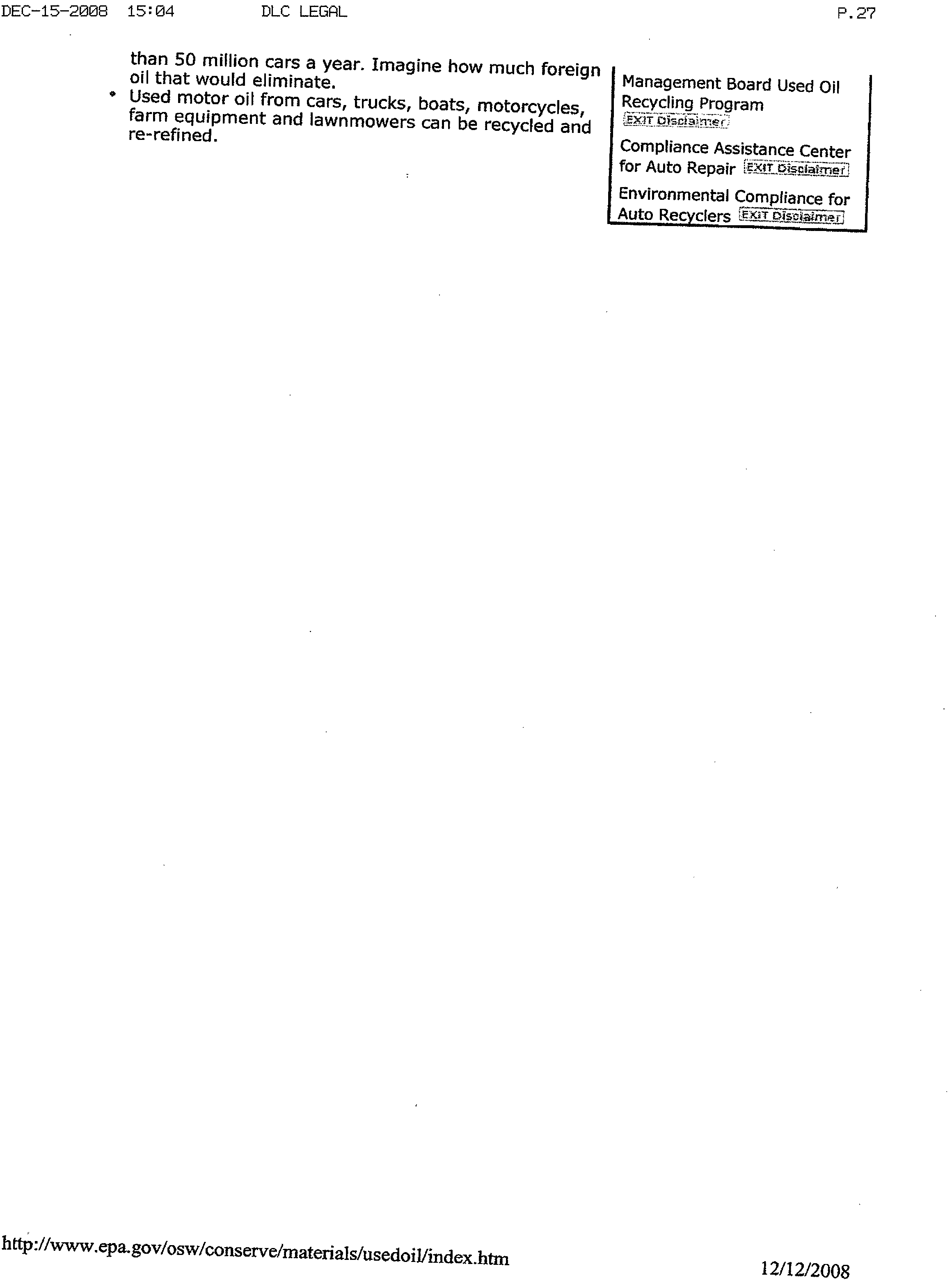DEC—15—2008
14:57
DLC
LEGflL
P.02
IN
THE
MATTER
OF:
PROPOSED
AMENDMENTS
TO
THE
BOARD’S
SPECIAL
WASTE
REGULATIONS
CONCERNING
USED
OIL,
35
ILL.
ADM.
CODE
808,
809
NOTICE
OF
FILING
Dorothy
Gunn,
Clerk,
Illinois
Pollution
Control
Board
James
R.
ThompsonCenter
100
W.
Randolph,
Suite
11-500
Chicago,
Illinois
60601
(ELECTRONIC
FILING)
Matthew
3.
Dunn
Environmental
Bureau
Chief
Office
of
the
Attorney
General
Environmental
Bureau
North
69
West
Washington
Street,
Suitel800
Chicago,
Illinois
60602
Claire
A.
Manning
Brown,
Hay
&
Stephens,
LLP
700
First
Mercantile
Bank
Building
205
South
Fifth
St.,
P.O.
Box
2459
Springfield,
Illinois
62705-2459
William
Richardson,
Chief
Legal
Counsel
Office
of
Legal
Counsel
Illinois
Dept.
of
Natural
Resources
One
Natural
Resources
Way
Springfield,
Illinois
62702-1271
Tim
Fox,
Hearing
Officer
Illinois
Pollution
Control
Board
James
R.
Thompson
Center
100
W.
Randolph
St.
Suite
11-500
Chicago,
Illinois
60601
Deirdre
K.
Hirner,
Executive
Director
Illinois
Environmental
Regulatory
Group
3150
Roland
Avenue
Springfield,
Illinois
62703
PLEASE
TAKE
NOTICE
that
I
have
today
filed
with
the
Office
of
the
Clerk
of
the
illinois
Pollution
Control
Board
the
ILLINOIS
ENVIRONMENTAL
PROTECTION
AGENCY’S
POST
HEARING
COMMENTS,
a
copy
of
which
is
herewith
served
upon
you.
DATE:
I
-
1021
North
Grand
Avenue
East
P.O.
Box
19276
Springfield,
Illinois
62794-9276
(217)
782-5544
ILLINOIS
ENVIRONMENTAL
PROTECTION
AGENCY
By:t.L4
StepiMnie
Flowers
Assistant
Counsel
Division
of
Legal
Counsel
RE
TUE
ILLINOIS
POLLUTION
CONTROL
BOARD
BE
CLEflK’
OFFIcE
)
)
DEC\
5
2U8
)
R06-20
STTE
OF
‘WNols
)
(Rulemaking
—Land)
u
IOfl
Control
Board
)
P
03
DEC—15—20
08
14:57
DLC
LEI3PL
BEFORE
THE
ILLINOiS
POLLUTION
CONTROL
BOARD
iN
THE
MATTER
OF:
)
)
PROPOSED
AMENDMENTS
TO
THE
)
R06-20
BOARD’S
SPECIAL
WASTE
)
(Rulemaking
—Land)
REGULATIONS
CONCERNiNG
)
USED
OIL,
35
ILL.
ADM.
CODE
808,
809
)
THE
ILLINOIS
ENVIRONMENTAL
PROTECTION
AGENCY’S
POST-HEARING
COMMENTS
NOW
COMES
the
Illinois
Environmental
Protection
Agency
(“illinois
EPA”),
by
and
through
one
of
its
attorneys,
Stephanie
Flowers,
and
respectfully
submits
the
following
post-
hearing
comments
in
the
above-entitled
matter
to
the
Illinois
Pollution
Control
Board
(“Board”).
The
Illinois
EPA
appreciates
this
opportunity
to
supplement
its
comments
and
testimony
already
flied
in
this
matter
and
presented
during
the
public
hearings
held.
I.
INTRODUCTION
The
Board’s
first
notice
proposal
allows
used
oil
as
defined
by
35
111.
Adm.
Code
739
(“Part
739”)
to
be
exempt
from
the
manifest
and
hauling
permit
requirements
of
35
Ui.
Adm.
Code
808
and
809
(“Parts
808
and
809”).
As
defined
in
Part
739,
used
oil
is
oil
that
has
been
used
and
hasbeen
contaminated
through
use.
Other
special
wastes
that
are
added
to
used
oil
after
it
has
been
generated,
that
are
not
themselves
used
oil,
do
not
become
used
oil,
but
become
regulated
as
used
oil
because
they
contain
used
oil.
These
other
special
wastes
may
exhibit
characteristics
different
from
used
oil
and
may
need
to
be
managed
differently
when
separated
from
used
oil.
Therefore,
the
Illinois
EPA
believes
these
other
special
wastes,
unless
otherwise
exempt,
must
be
subject
to
the
manifesting
and
permitting
requirements
of
Parts
808
and
809.
1
P.04
DEC—15—200
8
14:57
DLC
LEGFiL
Since
the
Board’s
first
notice
proposal
did
not
allow
post-use
mixtures
of
used
oil
and
other
special
waste
to
be
exempt
from
the
manifest
and
hauling
requirements,
NORA
is
requesting
that
the
manifest
exemption
and
permit
hauling
exemption
be
extended
to
four
categories
of
post-use
mixtures
of
used
oil
and
other
special
waste
that
are
regulated
by
Part
739.
The
Illinois
EPA
believes
that
only
used
oil
as
defined
in
and
managed
in
accordance
with
Part
739
and
not
materials
subject
to
regulation
as
used
oil
by
Part
739
should
be
exempt
from
the
requirements
of
Parts
808
and
809
regarding
manifests,
hauling
permits
and
facility
permits
requiring
local
siting
under
35
Ill.
Adm.
Code
807.
There
are
two
main
reasons
for
this
decision:
to
encourage
proper
recycling
and
to
insure
proper
management
of
wastes
that
are
added
to
used
oil.
The
Illinois
EPA
believes
it
is
likely
that
other
waste
added
in
to
the
used
oil
will
not
be
recycled,
but
will
be
burned
with
the
used
oil
or
treated
in
a
waste
water
treatment
unit.
Limiting
the
manifest
exemption
to
used
oil
as
defined
in
and
managed
in
accordance
with
Part
739,
as
the
Illinois
EPA
has
proposed,
encourages
the
generator
to
keep
waste
streams
separate
for
appropriate
management
and
recycling.
Therefore,
the
Illinois
EPA
objects
to
NORA’s
proposed
four
broad
categories
of
mixtures
being
included
in
the
manifest
and
hauling
permit
exemption
set
forth
in
the
Board’s
first
notice
proposal.
NORA
also
proposed
adding
language
to
the
tracking
requirements
of
Part
739.
The
language
would
require
Part
739
tracking
documents
to
be
analogous
to
a
manifest
without
the
requirement
of
the
document
being
the
uniform
hazardous
waste
manifest
prescribed
by
the
Illinois
EPA.
Since
the
Illinois
EPA
believes
only
used
oil
as
defined
in
and
managed
in
accordance
with
Part
739
should
be
allowed
a
manifest
exemption,
the
current
tracking
requirements
of
Part
739
are
sufficient.
Therefore,
the
Illinois
EPA
objects
to
amending
the
Part
739
tracking
requirements.
2
P.05
DEC—15—20
09
14:58
DLC
LEGAL
IL
POST-USE
MIXTURES
Of
the
four
categories
of
post-use
mixtures
of
used
oil
and
other
special
waste
identified
by
NORA
in
their
proposai,
the
generator
may
already
be
entitled
to
the
manifest
exemption
and
hauling
permit
exemption
set
forth
in
the
Board’s
first
notice
proposal.
The
Illinois
EPA
believes
there
may
be
some
confusion
on
NORA’s
part
about
which
wastes
would
be
exempt
from
manifests
under
the
language
in
the
Board’s
first
notice
proposal.
The
Board’s
proposed
language
in
the
first
notice
exempts
all
used
oil
as
defined
in
and
managed
in
accordance
with
Part
739
regardless
of
water
content.
In
addition,
it
is
the
Illinois
EPA’s
position
that
small
quantity
wastes
that
are
exempt
from
manifesting
before
mixture
with
used
oil
would
remain
exempt
under
the
Board’s
first
notice
proposal
pursuant
to
35
IlL
Adm.
Code
809.2
10
and
that
used
oil
collected
from
waste
water
treatment
units
would
be
exempt
under
the
Board’s
first
notice
proposal
pursuant
to
USEPA’s
clarification
letter
dated
March
22,
1994
andattached
hereto
as
Attachment
#1.
There
are
currently
manifest
exemptions
in
place
for
both
hazardous
waste
and
non-
hazardous
special
waste.
It
is
the
Illinois
EPA’s
position
that
if
a
manifest
exempt
waste
is
mixed
with
used
oil
as
defined
in
Part
739
(that
would
now
be
exempt
from
manifests
under
the
Board’s
first
notice
proposal)
the
mixing
of
two
manifest
exempt
wastes
together
would
not
make
the
resulting
mixture
subject
to
manifest.
A.
CONDiTIONALLY
EXEMPT
SMALL
QUANTITY
GENERATOR
HAZARDOUS
WASTE
Used
oil
that
is
mixed
with
conditionally
exempt
small
quantity
generator
hazardous
waste
may
be
cutting
oil
or
other
types
of
oil
that
was
contaminated
by
use
but
3
P.08
DEC—15--20
08
14:58
DLC
LEGFL
contains
mostly
water
and
trace
amounts
of
oil.
Therefore
the
resulting
mixture
will
behave
more
like
a
mixture
of
the
small
quantity
generator
hazardous
waste,
or
water,
rather
than
oil.
Since
conditionally
exempt
small
quantity
generator
hazardous
waste
is
exempt
from
manifests
pursuant
to
35
Ill.
Adm.
Code
72
1.105,
when
mixedwith
used
oil
as
defined
in
and
managed
in
accordance
with
Part
739
(that
would
now
be
exempt
from
manifests
under
the
Board’s
first
notice
proposal)
the
resulting
mixture
will
be
manifest
exempt.
However,
if
the
conditionally
exempt
small
quantity
generator
hazardous
waste
is
mixed
with
waste
other
than
used
oil
as
defined
in
Part
739,
the
resulting
mixture
may
need
to
be
managed
at
a
permitted
special
waste
facility
and
manifested
in
accordance
with
Part
809.
Additionally,
it
is
possible
that
a
small
quantity
generator
of
hazardous
waste
and
a
small
quantity
generator
of
non-hazardous
special
waste
could
mix
the
two
together
and
become
a
large
quantity
generator
of
hazardous
waste
or
a
large
quantity
generator
of
non-hazardous
special
waste.
Regulations
are
already
in
place
to
address
this
issue
and
the
Illinois
EPA
does
not
believe
it
is
appropriate
to
modify
the
hazardous
waste
and
special
waste
determination
regulations
or
large
quantity
generator
status
regulations
through
a
used
oil
manifest
exemption.
B.
CHARACTERISTIC
HAZARDOUS
WASTE
Used
oil
that
is
mixed
with
characteristic
hazardous
waste
may
becutting
oil
or
other
types
of
oil
that
was
contaminated
by
use
but
contains
mostly
water
and
trace
4
P.07
DEC—15—20
88
14:58
DLC
LE61L
amounts
of
oil.
Therefore
the
resulting
mixture
will
behave
more
like
a
mixture
of
the
characteristic
hazardous
waste,
or
water,
rather
than
oil.
Characteristic
hazardous
waste
becomes
exempt
from
RCRA
and
regulated
under
the
used
oil
regulations
when
mixed
with
used
oil
defined
in
Part
739
to
the
extent
that
the
characteristic
is
extinguished.
However,
because
the
characteristic
hazardous
waste
is
not
subject
to
a
manifest
exemption
prior
to
being
mixed
with
the
used
oil,
the
resulting
mixture
will
be
exempt
under
RCRA
but
will
be
subject
to
the
special
waste
regulations
including
the
manifest
and
hauling
pennit
requirements
of
Parts
808
and
809
and
the
facility
permit
requirements
of
35
111.
Adm.
Code
807.
NORA
argues
that
the
federal
regulations
allow
some
quantity
of
hazardous
waste
when
mixed
with
used
oil
to
be
regulated
as
used
oil.
Previous
testimony
bythe
Illinois
EPA
points
out
the
USEPA
acknowledged
that
individual
states
may
impose
more
stringent
standards
than
the
federal
requirements.
The
State
of
illinois
has
chosen
to
implement
a
special
waste
program
to
ensure
that
these
wastes
are
managed
properly
at
a
permitted
facility
that
is
subject
to
local
siting.
C.
FUELS
The
Illinois
EPA’s
position
is
that
unused
fuels
in
used
oil
are
not
a
special
waste
because
they
are
presumed
to
be
going
for
burning
(the
original
intended
use)
and
are
therefore
not
disposed.
Unused
fuel
would
include
off-spec
fuel,
such
as
fuel
removed
during
aircraft
maintenance
or
fuel
contaminated
with
water.
Fuels
would
not
be
subject
to
special
waste
manifesting
but
would
be
subject
to
Part
739
when
mixed
with
used
oil.
5
P.08
DEC—15—20
88
j4:58
DLC
LE6L
However,
the
latest
proposed
language
by
NORA
expands
the
exemption
beyond
fuels
to
include
normal
components
of
fuel.
Fuel
components
include
thesame
chemicals
that
are
used
as
fuel
additives,
in
small
amounts,
but
could
be
placed
in
the
used
oil
in
high
concentrations
and
could
have
been
used
as
a
solvent
before
they
were
mixed
with
the
oil.
A
mixture
of
this
type
may
contain
used
oil
as
defined
in
Part
739
but
will
be
mostly
water
combined
with
spent
solvent
or
some
other
contaminated
chemical.
The
resulting
mixture
may
not
have
thesame
chemical
or
physical
properties
as
the
normal
used
oil
stream
and
should
only
be
managed
at
a
facility
that
can
mange
the
waste
appropriately
which
the
Illinois
EPA
believes
is
a
properly
permitted
special
waste
facility.
USEPA
has
already
explained
that
even
petroleum
based
wastes
are
not
used
oil
if
they
were
not
used
as
a
lubricant.
They
indicate
that
the
contaminants
resulting
from
the
use
for
some
other
activity
such
as
a
solvent
may
result
in
contaminates
not
normally
associated
with
used
oil.
See
Attachment
#2
as
an
example
of
USEPA’s
position.
The
petroleum
based
solvent
in
this
USEPA
example
would
be
considered
a
normal
component
of
fuel
under
NORA’s
proposal
as
“normal
component
of
fuel”
has
not
been
defined
in
the
proposal.
1).
WASTEWATER
The
Illinois
EPA’s
position
is
that
wastewater
that
is
mixed
with
used
oil
through
use
or
unintentional
contamination
during
collection
or
storage
by
the
generator
is
subject
to
Part
739
and
should
be
allowed
a
special
waste
manifesting
exemption.
However,
the
IEPA
believes
that
there
are
possibly
only
a
few
scenarios
where
a
special
waste
6
P.09
DEC—15—20
09
14:59
DLC
LEGFIL
manifesting
exemption
would
apply.
One
is
cutting
fluids
that
contain
a
lot
of
water,
the
second
is
used
oil
that
contains
water
due
to
storage
contamination,
and
the
third
is
recovery
of
used
oil
spills.
In
contrast
NORA’s
proposal
would
exempt
mixtures
of
wastewater
with
de
minimis
amounts
of
used
oil.
The
proposal
does
not
identify
the
amount
of
oil
that
must
be
in
the
waste
water
to
allowthe
waste
stream
to
be
manifest
exempt.
NORA
testified
that
the
cle
minimis,
or
recoverable
amount
of
oil
is
different
for
different
receiving
facilities.
(See
October
1,
2008
Hearing
Transcript
Page
85
Line
17
through
Page
87
Line
4).
Therefore
the
generator
would
need
to
know
the
location
and
processing
abilities
of
the
receiving
facility
to
determine
if
the
manifest
exemption
applies
to
the
used
oil
mixture.
Also,
NORA’s
proposed
exemption
does
not
require
the
wastewater
to
be
in
the
used
oil
as
a
result
of
the
use
of
the
used
oil.
Therefore
the
source
of
the
wastewater
is
limitless
and
the
receiving
facility
would
have
no
idea
of
what
chemical
constituents
would
be
in
the
waste
water.
Illinois
EPA
is
concerned
that
NORA’s
proposal
may
encourage
mismanagement
of
other
waste
added
to
used
oil.
The
language
of
theexemption
fails
to
exclude
other
waste
from
the
exemption
if
added
to
the
recyclable
oil
for
the
sole
purpose
of
disposing
of
the
other
waste.
This
will
encourage
the
addition
of
other
wastes
to
the
used
oil
which,
according
to
NORA’s
witnesses,
will
either
be
discharged
through
a
wastewater
treatment
system
or
burned
along
with
the
used
oil,
regardless
if
that
is
the
appropriate
way
to
manage
thewaste.
(See
October
1,
2008
Hearing
Transcript
Page
32
Line
19
through
Page
33
Line
8,
Page
41
Lines
2-6,
and
Page
42
Lines
17-24).
Previous
testimony
by
the
Illinois
EPA
stated
that
it
is
not
the
Illinois
EPA’s
7
P.10
DEC—15—20
06
14:59
DLC
LEGRL
desire
or
the
intent
of
the
used
oil
regulations
to
encourage
the
mixing
of
other
wastes
with
the
used
oil,
but
to
recycle
each
waste
stream
separately.
The
wording
in
the
most
recent
NORA
proposal
does
not
sufficiently
address
these
concerns.
The
Illinois
EPA
would
also
like
to
point
out
that
USEPA
does
not
encourage
the
mixture
of
used
oil
and
other
waste.
The
Illinois
EPA
in
previous
testimony
identified
portions
of
the
federal
register
where
USEPA
discouraged
the
mixing
of
other
wastes
or
products
with
used
oil.
USEPA
has
also
developed
guidance
that
clearly
encourages
used
oil
generators
to
keep
their
used
oil
separate
from
other
wastes.
(See
USEPA
fact
sheets
attached
hereto
as
Attachment
#3
and
Attachment
#4).
It
should
also
be
noted
that
the
reason
the
management
standards
at
Part
739
require
used
oil
tanks,
containers,
and
fill
pipes
to
be
clearly
marked
with
the
words
“used
oil”
is
to
prevent
the
accidental
dumping
of
other
wastes
into
the
used
oil.
For
these
reasons
the
Illinois
EPA
believes
the
mixing
of
used
oil
with
other
special
waste
should
not
be
encouraged
by
providing
a
manifest
exemption
as
an
incentive
to
mix
these
wastes.
Mixtures
of
used
oil
and
other
wastes
may
change
the
characteristics
of
the
mixture
and
the
mixture
should
be
re-evaluated
after
mixing.
it
is
the
position
of
the
Illinois
EPA
that
in
each
individual
case,
before
mixing
the
generator
should
determine
if
each
waste
stream
is
subject
to
manifesting.
If
any
of
the
waste
streams
are
subject
to
manifest
before
mixing,
the
resulting
mixture
is
subject
to
manifesting.
If
mixing
the
waste
streams
together
changes
the
characteristics
of
the
waste,
the
mixing
activity
is
treatment
and
the
generator
must
re-evaluate
the
resulting
waste
stream
and
manage
it
in
accordance
with
the
applicable
regulations.
The
Illinois
EPA
believes
the
current
criteria
for
exemption
should
remain
dependent
on
the
quantity
and
characteristics
of
thewaste
both
before
and
after
mixing.
8
P.11
DEC—15—200
6
14:59
DLC
LEGFIL
In
sum,
it
is
the
Illinois
EPA’s
position
that
mixtures
of
used
oil
and
other
wastes
that
do
not
meet
the
definition
of
used
oil
in
Part
739,
that
are
not
otherwise
exempt
from
manifests
according
to
the
special
waste
or
hazardous
waste
regulations,
and
which
are
intentionally
added
to
the
used
oil
after
it
is
generated,
would
not
be
exempt
from
manifesting
and
hauling
permits
under
the
Board’s
first
notice
proposal
language
and
the
Illinois
EPA
remains
opposed
to
the
exemption
of
such
mixtures
from
manifesting
and
hauling
permits.
Mr.
Ray,
in
his
testimony
indicated
that
about
fifty
percent
of
his
company’s
customers
are
automotive
customers
and
fifty
percent
of
the
automotive
customers
are
conditionally
exempt
small
quantity
generators.
(See
October
1,
2008
Hearing
Transcript
Page
52
Lines
1-7).
Considering
this
testimony,
the
current
available
manifest
exemptions
and
the
manifest
exemption
for
used
oil
included
in
the
Board’s
first
notice
proposal,
the
Illinois
EPA
believes
that
most
used
oil
and
appropriate
used
oil
mixtures
will
be
exempt
from
manifests
if
the
language
in
the
Board’s
first
notice
proposal
is
adopted.
Ill.
COSTS
OF
PROPOSED
MANIFEST
EXEMPTION
NORA
argues
that
the
puipose
of
its
new
proposal
is
to
rid
the
used
oil
collection
system
of
duplicate
paperwork.
NORA’s
witnesses
stated
during
the
October
1,
2008
hearing
that
the
DOT
requirements
must
be
satisfied
by
a
completely
separate
document,
when
in
fact
they
can
be
satisfied
by
the
manifest.
(See
October
1,
2008
Hearing
Transcript
Page
17
Lines
3-12,
Page
20
Lines
13-17,
Page
69
Lines
10-17,
and
Page
144
Lines
14-18.)
Please
see
Attachment
#5
for
a
statement
at
DOT’s
website
stating
that
a
DOT
document
does
not
have
to
be
a
separate
piece
of
paper
in
addition
to
a
manifest.
9
P.12
DEC—15—20
08
14:59
DLC
LE6L
NORA
proposes
amending
the
Part
739
tracking
requirements
to
include
all
the
information
the
Illinois
EPA
or
Board
deems
necessary
to
track
the
shipments
to
the
used
oil
recycler
and
to
require
the
tracking
and
recordkeeping
for
the
generators,
transporters,
and
receiving
facilities.
This
would
effectively
be
a
free
form
manifest
that
would
contain
all
the
information
and
be
subject
to
all
of
the
recordkeeping
requirements
of
a
manifest,
without
the
prescribed
form
of
a
uniform
hazardous
waste
manifest.
However,
the
Illinois
EPA
believes
that
NORA’s
new
proposal
would
actually
create
additional
paperwork
and
burdensome
testing
for
the
generators
of
used
oil.
NORA’s
proposal
would
require
the
generator
to
determine
the
percent
water,
BTU
value
and
amount
of
recoverable
oil
in
certain
mixtures
before
they
would
be
able
to
use
the
manifest
exemption.
The
generator
would
need
to
keep
records
of
this
testing
to
be
used
to
support
their
determination.
NORA’s
proposal
would
also
require
specific
test
methods
for
determining
percent
water
and
BTU
content.
Without
these
standardized
test
methods,
it
will
be
difficult
for
the
illinois
EPA
to
determine
compliance
with
the
manifest
exemption.
Different
sampling
and
test
methods
may
produce
different
results
and
may
vary
in
cost.
Without
specifying
sampling
and
test
methods,
other
factors
beyond
appropriateness
of
the
method
may
be
the
incentive
for
the
generator
in
choosing
a
method.
Mr.
Lenz
testified
that
the
generator
could
get
some
of
the
required
information
from
Material
Safety
Data
Sheets
(“MSDS”).
(See
October
1,
2008
Hearing
Transcript
Page
63
Lines
18-22).
However,
none
of
this
information
is
required
by
law
to
be
placed
on
the
MSDS
and
there
is
no
governing
body
that
routinely
polices
the
accuracy
of
MSDS.
(See
29
CFR
1910.1200(g)
which
identifies
the
information
required
on
an
MSDS).
In
addition,
the
MSDS
only
identifies
contents
of
the
product
before
use.
Therefore,
even
if
the
MSDS
information
is
10
P.13
DEC—15—20
08
15:00
DLC
LEG1L
available,
in
many
instances
the
generator
would
be
forced
to
conduct
testing
to
determine
the
post-use
percentage
of
water,
BTU
value
and
amount
of
recoverable
oil.
In
addition
to
the
testing
and
supporting
documentation,
the
generator
would
also
be
required
to
keep
copies
of
the
new
free
form
manifest
proposed
by
NORA.
In
contrast,
in
the
Board’s
first
notice
proposal,
generators
that
were
eligible
for
the
used
oil
manifest
exemption
would
only
be
subject
to
the
current
used
oil
tracking
requirements
which
do
not
require
generators
to
keep
records.
Furthermore,
NORA
members
that
testified
on
this
proposal
at
the
October
1,
2008
hearing
were
exclusively
used
oil
transporters,
transfer
facilities
and
marketers.
The
generators,
smaller
transporters,
Illinois
processors
and
permitted
special
waste
treatment
facilities
that
are
currently
permitted
to
take
post-use
mixtures
were
not
represented
and
may
not
be
aware
of
the
changes
NORA’s
proposal
would
require
of
them
if
adopted.
The
illinois
registered
processors
of
used
oil
and
the
permitted
special
waste
treaters
who
would
receive
the
segregated
special
waste
that
is
not
used
oil
may
prefer
that
the
used
oil
and
other
special
waste
be
kept
separate
for
treatment.
NOP.A
testified
that
the
cost
of
preparing,
storing
and
processing
the
manifest
is
currently
estimated
to
be
$18/manifest.
(See
October
1,
2008
Hearing
Transcript
Page
176
Lines
1-7).
If
in
fact
NORA
members
made
the
changes
discussed
in
the
most
recent
hearing
and
added
the
manifest
information
and
recordkeeping
requirements
into
the
proposal,
the
Illinois
EPA
believes
the
real
cost
savings
considering
the
additional
cost
of
preparing,
storing
and
processing
the
freeform
manifest
would
be
less
than
$18/manifest.
And
with
the
additional
testing
requirements,
supporting
documentation
and
freeform
manifest
retention
for
generators
the
cost
to
the
used
oil
industry
would
actually
increase.
ii
P
14
DEC—152
008
15:00
DLC
LE6PL
Because
of
the
reasons
specified
above
the
Illinois
EPA
objects
to
any
other
wastes
besides
used
oil
as
defined
in
and
managed
in
accordance
with
Part
739
being
included
in
the
manifest
and
hauling
permit
exemption
set
forth
in
the
Board’s
first
notice
proposal,
objects
to
amending
thetracking
requirements
of
Part
739,
and
recommends
that
the
Board
adopt
the
language
of
its
first
notice
proposal.
Respectfully
submitted,
ILLINOIS
ENVIRONMENTAL
PROTECTION
AGENCY.
St
anie
Flowers
Assistant
Counsel
Division
of
Legal
Counsel
DATED:/2
/$O
1021
North
Grand
Avenue
East
P.O.
Box
19276
Springfield,
Illinois
62794-9276
(217)
782-5544
12
DLC
LE6AL
P.15
DEC—15—2
008
15:00
CERTIFICATE
OF
SERVICE
I,
STEPHANIE
FLOWERS,
an
attorney,
do
certify
that
I
filed
electronically
with
the
Office
of
the
Clerk
of
the
illinois
Pollution
Control
Board
the
ILLiNOIS
ENVIRONMENTAL
PROTECTION
AGENCY’S
POST-HEARiNG
COMMENTS
and
will
cause
the
same
to
be
served
upon
the
following
persons,
by
placing
a
true
and
correct
copy
in
an
envelope
addressed
to:
Dorothy
Gunn,
Clerk,
Illinois
Pollution
Control
Board
James
R.
Thompson
Center
100
W.
Randolph,
Suite
11-500
Chicago,
Illinois
60601
Matthew
J.
Dunn
Environmental
Bureau
Chief
Office
of
the
Attorney
General
Environmental
Bureau
North
69
West
Washington
Street,
Suite
1800
Chicago,
Illinois
60602
Claire
A.
Manning
Brown,
Hay
&
Stephens,
LLP
700
First
Mercantile
Bank
Building
205
South
Fifth
St.,
P.O.
Box
2459
Springfield,
Illinois
62705-2459
William
Richardson,
Chief
Legal
Counsel
Office
of
Legal
Counsel
Illinois
Dept.
of
Natural
Resources
One
Natural
Resources
Way
Springfield,
Illinois
62702-1271
Tim
Fox,
Hearing
Officer
Illinois
Pollution
Control
Board
James
R.
Thompson
Center
100
W.
Randolph
St.
Suite
11-500
Chicago,
Illinois
60601
Deirdre
K.
Hirner,
Executive
Director
Illinois
Environmental
Regulatory
Group
215
East
Adams
Street
Springfield,
Illinois
62701
and
mailing
it
by
First
Class
Mail
from
Springfield,
illinois
on
December
15,2008
with
sufficient
postage
affixed.
DATED:__________
1021
North
Grand
Avenue
East
P.O.
Box
19276
Springfield,
Illinois
62794-92
76
(217)
782-5544
t
STEPHthJ4IE
FLOWERS
P.16
DEC—15—20
08
15:00
DLC
LE61L
u.tacnmeflt
i
9592.1994(02)
United
States
Environmental
Protection
Agency
Washington,
D.C.
20460
Office
of
Solid
Waste
and
Emergency
Response
March
22,
1994
Mr.
Gary
F.
Lmdgren
Vice
President,
Environmental
Compliance
Heritage
Environmental
Services,
Inc.
7901
West
Morris
Street
Indianapolis,
Indiana
46231
Dear
Mr.
Lindgren:
Thank
you
for
your
letters
of
August
6,
1993,
and
February
8,
1994,
requesting
clarification
of
the
Environmental
Protection
Agency’s
(EPA)
Recycled
Used
Oil
Management
Standards
as
they
apply
to
wastewater
treatment
activities.
I
apologize
for
the
delay
in
responding
to
your
request.
As
you
correctly
note
in
your
letter,
wastewater
that
contains
used
oil
meets
the
§279.1
definition
of
used
oil
and
is
subject
to
regulation
under
the
used
oil
management
standards.
You
first
ask
whether
the
oil
that
is
recovered
from
such
wastewater
during:
a)
treatment
to
meet
a
Clean
Water
Act
(CWA)
permit
discharge
limit;
or
b)
a
used
oil
recovery
process,
would
also
be
considered
used
oil
under
§279.1.
The
answer
in
both
cases
is
yes.
Used
oil
that
is
recovered
from
wastewater
during
treatment
to
make
the
wastewater
acceptable
for
discharge
under
a
CWA
permit
is
regulated
as
used
oil.
Similarly,
oil
recovered
from
wastewater
generated
during
a
used
oil
recovery
process
is
also
considered
used
oil
for
regulatory
purposes.
Your
second
question
is
whether
residues
or
sludges
from
CWA
treatment
of
wastewater
containing
used
oil
is
included
in
the
definition
of
used
oil.
In
technical
amendments
and
corrections
to
the
used
oil
rule,
published
on
May
3,
1993,
EPA
clarified
that
used
oil
residues
and
sludges
are
subject
to
regulation
under
the
used
oil
management
standards.
(58
FR
26422)
Finally,
you
ask
whether
EPA
differentiates
between
a
CWA
RO
11818
DEC—15—2009
15:01
DLC
LE6L
P.17
wastewater
treatment
operation
that
includes
oil/water
separation
and
a
used
oil
processing
operation
that
includes
CWA
permitted
oil/water
separation.
EPA
specffically
addressed
this
issue
in
recently
issued
amendments
to
the
final
used
oil
regulations.
These
amendments
were
signed
by
the
EPA
administrator
on
February
25,
1994,
and
have
been
sent
to
the
Federal
Register
for
publication.
A
pre-publication
copy
of
the
final
rule
is
attached.
The
attached
final
rule
clarifies
that
separating
used
oil
from
wastewater
generated
on-site
to
make
the
wastewater
acceptable
for
discharge
pursuant
to
a
CWA
discharge
permit
are
not
subject
to
the
used
oil
processor
standards,
provided
that
the
recovered
used
oil
is
not
being
sent
to
an
off-site
used
oil
burner
(see
§279.20(b)(2)(ii)(B)).
As
discussed
in
the
attached
preamble,
under
§279
20(b)(2)(ii)(B),
oil/water
separation
activities
conducted
by
a
used
oil
processor
(for
purposes
of
wastewater
discharge)
on
wastewater
which
has
been
generated
by
that
processor
are
not
subject
to
the
Subpart
F
processor
standards
(see
pg.38).
In
other
words,
EPA
does
not
differentiate
between
oil/water
separation
activities
conducted
by
used
oil
processors
and
oil/water
separation
activities
undertaken
by
non-used
oil
processors.
Provided
that
the
wastewater
is
generated
on—site,
neither
activity
is
subject
to
the
used
oil
processor
standards.
However,
as
further
clarified
in
the
preamble,
persons
who
perform
oil/water
separation
activities
on
wastewater
that
is
received
from
off-site
would
be
considered
used
oil
processors
(see
pg.39
of
the
attached).
You
should
note,
however,
that
the
Federal
used
oil
regulations
(including
the
amendments
cited
in
this
letter)
are
not
currently
in
effect
in
States
authorized
to
implement
the
hazardous
waste
program
and
will
not
become
effective
in
such
states
until
they
are
adopted
as
State
law.
Also,
it
is
important
to
note
that
State
regulations
may
be
more
stringent
than
Federal
regulations.
If
you
have
any
further
questions,
please
contact
Eydie
Pines
of
my
staff
at
(202)
260-3509.
Sincerely,
Michael
Shapiro
Director
Office
of
Solid
Waste
Attachment
RO
11818
P.18
C
LEGFL
L4.uLueUz.
DEC—152
8
Ø
6
j5:Ø1
Mr.
Christoper
Harris
Harris,
Tarlow
&
Stonecipher
1439
West
Babcock
Bozeman,
Montana
59715
Dear
Mr.
Harris:
Thank
you
for
your
letter
of
September
17,
1998
requesting
an
interpretation
of
the
federal
used
oil
regulations.
Based
on
subsequent
conversations
between
you
and
my
staff,
you
specifically
asked
whether
a
spent
petroleum-based
solvent
that
includes
oily
residues
as
a
result
of
the
solvent’s
use
to
clean
machine
parts
would
be
regulated
as
used
oil
under
40
CFR
Part
279.
The
Agency
does
not
consider
such
spent
petroleum-based
solvent
to
be
used
oil
and
did
not
intend
that
it
be
regulated
as
such.
Accordingly
1
when
a
petroleum-based
solvent
is
spent
(i.e.,
no
longer
possesses
a
solvent
property)
and/or
is
taken
out
of
service,
it
becomes
a
waste
subject
to
a
hazardous
waste
determination
(see
40
CFR
262.11).
Generators
may
use
their
knowledge
or
testing
to
determine
whether
a
waste
is
hazardous.
When
the
Agency
promulgated
the
Used
Oil
Management
Standards
(57
FR
41566,
September
10,1992)
it
discussed
its
view
that
spent
petroleum-based
solvents
are
not
included
in
the
definition
of
used
oiL
Specifically,
the
preamble
states:
“(t)oday’s
definition
(of
used
oil)
does
not
include
oil-based
products
used
as
solvents
refined
from
crude
oil
or
manufactured
from
synthetic
materials.
The
Agency
has
always
viewed
petroleum-based
solvents
as
wastes
separate
and
distinct
from
used
oil”
(57
FR
41566
at
41574).
The
Agency
continues
to
view
spent
petroleum-based
solvents
as
wastes
separate
and
distinct
from
used
oil,
because
the
source
of
contamination
in
used
petroleum-based
solvents
is
difficult
to
determine.
Petroleum-based
solvents,
for
instance,
are
used
as
cleaning
agents,
degreasing
fluids,
and
part-cleaning
solvents
in
the
automotive
and
vehicle
maintenance
industry,
in
metalworking
operations,
and
in
other
similar
applications.
The
process
of
removing
oily
residues
from
parts
with
a
petroleum-based
solvent
not
only
removes
the
oily
residues
by
chemically
dissolving
RO
14396
P.19
DEC—15—20
09
15:01
DLC
LEGFL
them,
but
it
also
may
remove
solids
or
other
organic-based
materials
such
as
metal
shavings,
waste
gasoline,
polychiorinated
biphenyls,
pesticides,
and
chlorinated
solvents.
Of
course,
spent
petroleum-based
solvents
that
are
intentionally
mixed
with
batches
of
used
oil
(to
make
fuel
oils,
for
example)
can
be
regulated
as
used
oil
as
provided
in
40
CFR
279.10(b).
It
is
important
to
note,
however,
that
even
though
a
solvent
may
be
ignitable-only
or
non-hazardous
prior
to
use,
once
the
solvent
has
been
used,
itmay
contain
other
hazardous
contaminants
as
a
result
of
that
usage.
Therefore,
a
hazardous
waste
determination
would
be
required
prior
to
mixing
spent
solvents
with
batches
of
used
oil.
Finally,
it
is
also
important
to
note,
that
EPA
regional
offices
and
states
authorized
to
implement
the
RCRA
program
make
determinations
regarding
the
requirements
that
apply
in
specific
situations.
Also,
some
states
have
programs
that
are
more
stringent
than
the
federal
hazardous
waste
arid
used
oil
programs.
If
you
have
any
further
questions
regarding
the
federal
used
oil
regulations,
please
contact
Mike
Svizzero
of
my
staff
at
(703)
308-0046.
Sincerely,
Stephen
Heare,
Acting
Director
Permits
and
State
Programs
Division
RO
14396
DEC—15—2008
15:02
DLC
LEI3AL
P.20
Attachutent
3
http
://www
.epa
qov/osw/conserve/materials/usedoi!!usedoiLhtrn#standards
Last
updated
on
Friday,
December
12th,
2008.
j
Wastes
-
Resource
Conservation
-
Common
Wastes
&
Materials
4
4t
You
are
here:
EPA
Home
Wastes
Resource
Conservation
Common
Wastes
&
Materials
Used
Oil
Management
Program
Publications
Managing
Used
Oil:
Advice
for
Small
Businesses
•
Used
Oil
Management
•
Basic
Information
•
Laws
&
Regulations
•
Campaign
•
Publications
Managing
Used
Oil:
Advice
for
Small
Businesses
•
What
is
Used
Oil?
—
How
Is
Used
Oil
Recycled?
•
gs
My
Business
Handle
Used
Oil?
°
What
Standards
Should
My
Business
Follow?
•
How
Should
My
Business
Manage
Used
Oil
Filters?
•
How
Can
My
Business
Avoid
Costly
Cleanups?
•
What
Else
Can
My
Business
Do
to
Conserve
Oil?
•
SuDporting
Documents
This
fact
sheet
contains
valuable
information
for
businesses
such
as
service
stations,
fleet
maintenance
facilities,
and
“quick
lube”
shops
that
generate
and
handle
used
oil.
It
summarizes
the
U.S.
Environmental
Protection
Agency’s
(EPA’s)
used
oil
management
standards--a
set
of
“good
housekeeping”
requirements
for
used
oil
handlers.
These
requirements
are
detailed
in
Title
40
of
the
Code
of
Federal
Regulations
(CFR)Part
279.
Small
businesses
should
also
refer
to
EPA’s
Emergency
Response
Division’s
Information
Line
at
202
260-2342
for
information
on
how
to
manage
spills.
What
is
Used
Oil?
EPA’s
regulatory
definition
of
used
oil
is
as
follows:
Used
oil
is
any
oil
that
has
been
refined
from
crude
oil
or
any
synthetic
oil
that
has
been
used
and
as
a
result
of
such
use
is
contaminated
by
physical
or
chemical
impurities.
Simply
put,
used
oil
is
exactly
what
its
name
implies—any
petroleum-based
or
synthetic
oil
that
has
been
used.
During
normal
use,
impurities
such
as
dirt,
metal
scrapings,
water,
or
chemicals
can
get
mixed
in
with
the
oil,
so
that
in
time
the
oil
no
longer
performs
well.
Eventually,
this
used
oil
must
be
replaced
with
virgin
or
re-refined
oil
to
do
the
job
at
hand
EPA’s
used
oil
management
standards
include
a
three-pronged
approach
to
determine
if
a
substance
meets
the
definition
of
used
oil.
To
meet
EPA’s
definition
of
used
oil,
a
substance
must
meet
each
of
the
following
three
criteria:
•
OrIgin
—
the
first
criterion
for
identifying
used
oil
is
based
on
the
origin
of
the
oil.
Used
oil
must
have
been
refined
from
crude
oil
or
made
from
synthetic
materials.
Animal
and
vegetable
oils
are
excluded
from
EPA’s
definition
of
used
oil.
•
Use
the
second
criterion
is
based
on
whether
and
how
the
oil
is
used.
Oils
used
as
http://www.epa.gov/osw/conserve/materials/usedoilJusecloil.htm
12/12/2008
DEC—15—2008
15:02
DLC
LEGflL
P.21
lubricants,
hydraulic
fluids,
heat
transfer
fluids,
buoyants,
and
for
other
similar
purposes
are
considered
used
oil.
Unused
oil
such
as
bottom
clean-out
waste
from
virgin
fuel
oil
storage
tanks
or
virgin
fuel
oil
recovered
from
a
spill,
do
not
meet
EPA’s
definition
of
used
oil
because
these
oils
have
never
been
“used.
7
’
EPA’s
definition
also
excludes
products
used
as
cleaning
agents
or
solely
for
their
solvent
properties,
as
well
as
certain
petroleum-derived
products
like
antifreeze
arid
kerosene.
Contaminants
—
the
third
criterion
is
based
on
whether
or
not
the
oil
is
contaminated
with
either
physical
or
chemical
impurities.
In
other
words,
to
meet
EPA’s
definition,
used
oil
must
become
contaminated
as
a
result
of
being
used.
This
aspect
of
EPA’s
definition
includes
residues
and
contaminants
generated
from
handling,
storing,
and
processing
used
oil.
Physical
contaminants
could
include
metal
shavings,
sawdust,
or
dirt.
Chemical
contaminants
could
include
solvents,
halogens,
or
saltwater.
Table
of
What
Used
OH
Is
and
Is
Not
Used
Oil
Is:!
•
Synthetic
oil
—
usually
derived
from
coal,
shale,
or
polymer-based
starting
material.
•
Engine
oil
typically
includes
gasoline
and
diesel
engine
crankcase
oils
and
piston-engine
oils
for
automobiles,
trucks,
boats,
airplanes,
locomotives,
and
heavy
equipment.
•
Transmission
fluid.
•
Refrigeration
oil.
•
Compressor
oils.
•
Metalworking
fluids
and
oils.
•
Laminating
oils.
•
Industrial
hydraulic
fluid.
•
Copper
and
aluminum
wire
drawing
solution.
•
Electrical
insulating
oil.
•
Industrial
process
oils.
•
Oils
used
as
buoyants.
*
This
list
does
not
include
all
types
of
used
oil.
How
is
Used
OH
Recycled?
Used
Oil
Is
Not:
•
Waste
oil
that
is
bottom
clean-out
waste
from
virgin
fuel
storage
tanks,
virgin
fuel
oil
spill
deanups,
or
other
oil
wastes
that
have
not
actually
been
used.
•
Products
such
as
antifreeze
and
kerosene.
•
Vegetable
and
animal
oil,
even
when
used
as
a
lubricant.
•
Petroleum
distillates
used
as
solvents.
Oils
that
do
not
meet
EPA’s
definition
of
•
used
oil
can
still
pose
a
threat
to
the
environment
when
disposed
of
and
could
be
subject
to
the
RCRA
regulations
for
hazardous
waste
management.
Once
oil
has
been
used,
it
can
be
collected,
recycled,
and
used
over
and
over
again.
An
estimated
380
million
gallons
of
used
oil
are
recycled
each
year.
Recycled
used
oil
can
sometimes
be
used
again
for
the
same
job
or
can
take
on
a
completely
different
task.
For
example,
used
motor
oil
can
be
re-refined
and
sold
at
the
store
as
motor
oil
or
processed
for
furnace
fuel
oil.
Aluminum
rolling
oils
also
can
be
filtered
on
site
and
used
over
again.
Used
Oil
Can
Be
Recycled
in
the
Following
Ways
*
Reconditioned
on
site,
which
involves
removing
impurities
from
the
used
oil
and
using
it
again.
While
this
form
of
recycling
might
not
restore
the
oil
to
its
original
condition,
it
does
prolong
its
life.
•
Inserted
into
a
petroleum
refinery,
which
involves
introducingused
oil
as
a
feedstock
into
either
the
front
end
of
the
process
or
the
coker
to
produce
gasoline
and
coke.
•
Re-refined,
which
involves
treating
used
oil
to
remove
impurities
so
that
it
can
be
http:/lwww.epa.gov/osw/conserve/materials/usedoillusedoil.htm
12/12/2008
P.22
DEC—15—200B
1502
DLC
LE6FL
used
as
a
base
stock
for
new
lubricating
oil.
Re-refining
prolongs
the
life
of
the
oil
resource
indefinitely.
This
form
of
recycling
is
the
preferred
option
because
it
closes
the
recycling
loop
by
reusing
the
oil
to
make
the
same
product
that
it
was
when
it
started
out,
and
therefore
uses
less
energy
and
less
virgin
oil.
Processed
and
burned
for
energy
recovery,
which
involves
removing
water
and
particulates
so
that
used
oil
can
be
burned
as
fuel
to
generate
heat
or
to
power
industrial
operations.
This
form
of
recycling
is
not
as
preferable
as
methods
that
reuse
the
material
because
it
only
enables
the
oil
to
be
reused
once.
Nonetheless,
valuable
energy
is
provided
(about
the
same
as
provided
by
normal
heating
oil).
Recycling
Used
Oil
Es
Good
for
the
Environment
and
the
Economy
-
Here’s
Proof
•
Re-refining
used
oil
takes
only
about
one-third
the
energy
of
refining
crude
oil
to
lubricant
quality.
•
It
takes
42
gallons
of
crude
oil,
but
only
one
gallon
of
used
oil,
to
produce
2
1/2
quarts
of
new,
high-quality
lubricating
oil.
•
One
gallon
of
used
oil
processed
for
fuel
contains
about
140,000
British
Thermal
Units
(BTUs)
of
energy.
Does
My
Business
Hand’e
Used
Oil?
The
following
paragraphs
describe
different
types
of
businesses
that
handle
used
oil.
•
Generators
are
businesses
that
handle
used
oil
through
commercial
or
industrial
operations
or
from
the
maintenance
of
vehicles
and
equipment.
Generators
are
the
largest
segment
of
the
used
oil
industry.
Examples
of
common
generators
are
car
repair
shops,
service
stations,
quick
lube
shops,
government
motor
pools,
grocery
stores,
metal
working
industries,
and
boat
marinas.
Farmers
who
produce
less
than
an
average
of
25
gallons
of
used
oil
per
month
are
excluded
from
generator
status.
Individuals
who
generate
used
oil
through
the
maintenance
of
their
personal
vehicles
and
equipment
are
not
subject
to
regulation
under
the
used
oil
management
standards.
Collection
centers
and
aggregation
points
are
facilities
that
accept
small
amounts
of
used
oil
and
store
it
until
enough
is
collected
to
ship
it
elsewhere
for
recycling.
Collection
centers
typically
accept
used
oil
from
multiple
sources
that
include
both
businesses
and
individuals.
Aggregation
points
collect
oil
only
from
places
run
by
the
same
owner
or
operator
and
from
individuals.
Transporters
are
companies
that
pick
up
used
oil
from
all
sources
and
deliver
it
to
re-refiners,
processors,
or
burners.
Transfer
facilities
include
any
structure
or
area
where
used
oil
is
held
for
longer
than
24
hours,
but
not
longer
than
35
days.
Examples
of
transfer
facilities
are
loading
docks
and
parking
areas.
•
Re-refiners
and
processors
are
facilities
that
blend
or
remove
impurities
from
used
oil
so
that
it
can
be
burned
for
energy
recovery
or
reused.
Included
in
this
category
are
re-refiners
who
process
used
oil
so
that
it
can
be
reused
in
a
new
product
such
as
a
lubricant
and
recycled
again
and
again.
EPA’s
management
standards
primarily
focus
on
this
group
of
used
oil
handlers.
•
Burners
burn
used
oil
for
energy
recovery
in
boilers,
industrial
furnaces,
or
in
hazardous
waste
incinerators.
•
Marketers
are
handlers
who
either
a)
direct
shipments
of
used
oil
to
be
burned
as
fuel
in
regulated
devices
or,
b)
claim
that
certain
EPA
specifications
are
met
for
used
oil
to
be
burned
for
energy
recovery
in
devices
that
are
not
regulated.
They
also
sometimes
help
move
shipments
of
used
oil
to
burners.
By
definition,
marketers
must
also
fall
into
at
least
one
of
the
above
categories.
What
Standards
Should
My
Business
Follow?
If
your
business
generates
or
handles
used
oil,
there
are
certain
good
housekeeping
practices
that
you
must
follow.
These
required
practices,
called
“management
standards,”
were
http://www.epa.gov/osw/conserve/materials/usedoillusedoil.htm
12/12/2008
P.23
DEC—15—20
06
15:03
DLC
LEGAL
developed
by
EPA
for
businesses
that
handle
used
oil.
The
management
standards
are
common
sense,
good
business
practices
designed
to
ensure
the
safe
handling
of
used
oil,
to
maximize
recycling,
and
to
minimize
disposal.
The
standards
apply
to
all
used
oil
handlers,
regardless
of
the
amount
of
the
oil
they
handle.
Although
different
used
oil
handlers
may
have
specific
requirements,
the
following
requirements
are
common
to
all
types
of
handlers.
These
requirements
relate
to
storage
and
to
cleaning,
up
leaks
and
spills,
as
follows.
•
Label
all
containers
and
tanks
as
Used
Oil.
•
Keep
containers
and
tanks
in
good
condition.
Don’t
allow
tanks
to
rust,
leak,
or
deteriorate.
Fix
structural
defects
immediately.
•
Never
store
used
oil
in
anything
other
than
tanks
and
storage
containers.
Used
oil
may
also
be
stored
in
units
that
are
permitted
to
store
regulated
hazardous
waste.
Tanks
and
containers
storing
used
oil
do
not
need
to
be
RCRA
permitted,
however,
as
long
as
they
are
labeled
and
in
good
condition.
Storage
of
used
oil
in
lagoons,
pits,
or
surface
impoundments
that
are
not
permitted
under
RCRA
is
prohibited.
Oil
Leaks
and
Spills
•
Take
steps
to
prevent
leaks
and
spills.
Keep
machinery,
equipment
containers,
and
tanks
in
good
working
condition
and
be
careful
when
transferring
used
oil.
Have
sorberit
materials
available
on
site.
•
If
a
spill
or
leak
occurs,
stop
the
oil
from
flowing
at
the
source.
If
a
leak
from
a
container
or
tank
can’t
be
stopped,
put
the
oil
in
another
holding
container
or
tank.
•
Contain
spilled
oil.
For
example,
containment
can
be
accomplished
by
erecting
sorbent
berms
or
by
spreading
a
sorbent
over
the
oil
and
*
Clean
up
the
oil
and
recycle
the
used
oil
as
you
would
have
before
it
was
spilled.
If
recycling
is
not
possible,
you
first
must
make
sure
the
used
oil
is
not
a
hazardous
waste
and
dispose
of
it
appropriately.
All
used
cleanup
materials,
from
rags
to
sorbent
booms,
that
contain
free-flowing
used
oil
also
must
be
handled
according
to
the
used
oil
management
standards.
Remember,
all
leaked
and
spilled
oil
collected
during
cleanup
must
be
handled
as
used
oil.
if
you
are
a
used
oil
handler,
you
should
become
familiar
with
these
cleanup
methods.
They
may
also
be
part
of
a
spill
response
action
plan.
•
Remove,
repair,
or
replace
the
defective
tank
or
container
immediately.
Record
Keeping
EPA
uses
12-digit
identification
(ID)
numbers
to
track
used
oil.
Transporters
hauling
used
oil
must
have
a
valid
EPA
ID
number,
and
generators,
collection
centers,
and
aggregation
points
must
use
transporters
with
EPA
ID
numbers
for
shipping
used
oil
off
site.
If
you
need
an
ID
number,
contact
your
EPA
regional
office
or
your
state
director.
Generators,
collection
centers,
aggregation
points,
and
any
handler
that
transports
used
oil
in
shipments
of
less
than
55
gallons
do
not
need
an
ID
number,
but
may
need
a
state
or
local
permit.
Used
oil
transporters,
processors,
burners,
and
marketers
also
must
record
each
acceptance
and
delivery
of
used
oil
shipments.
Records
can
take
the
form
of
a
log,
invoice,
or
other
shipping
document
and
must
be
maintained
for
three
years.
Re-refiners,
processors,
transfer
facilities,
and
burners
must
have
secondary
containment
systems
(e.g.,oil-impervious
dike,
berm,
or
retaining
wall
and
a
floor)
so
that
oil
can
not
reach
the
environment
in
the
event
of
a
leak
or
spill.
EPA
also
encourages
generators
to
use
a
secondary
containment
system
to
prevent
used
oil
from
contaminating
the
environment.
Burners
of
used
oil
that
meets
a
certain
set
of
quality
standards
called
the
used
oil
specifications
are
not
regulated
under
the
used
oil
management
standards,
as
Tong
as
the
used
oil
is
burned
in
appropriate
boilers,
furnaces,
or
incinerators.
Know
and
understand
your
state
regulations
governing
the
management
of
used
oil
they
http://www.epa.gov/osw/conserve/materials/usedoillusedoil.htm
12/12/20flR
P.24
DEC—15—20
08
15:03
DLC
LEGAL
might
be
stricter
than
EPA’s.
Contact
your
state
or
local
environmental
agency
to
determine
your
best
course
of
action.
Mixing
Used
Oil
and
Hazardous
Waste
In
addition
to
EPA’s
used
oil
management
standards,
your
business
may
be
required
to
comply
with
federal
and
state
hazardous
waste
regulations
If
your
used
oil
becomes
contaminated
from
mixing
it
with
hazardous
waste.
If
used
oil
is
mixed
with
hazardous
waste,
it
probably
will
have
to
be
managed
as
a
hazardous
waste.
Hazardous
waste
disposal
is
a
lengthy,
costly,
and
strict
regulatory
process.
The
only
way
to
be
sure
your
used
oil
does
not
become
contaminated
with
hazardous
waste
is
to
store
it
separately
from
all
solvents
and
chemicals
and
not
to
mix
it
with
anything.
How
Should
My
Business
Manage
Used
Oil
Filters?
The
Filter
Manufacturers’
Council
maintains
a
regulatory
hotline
and
database
to
encourage
the
proper
management
of
used
oil
filters.
By
calling
the
hotline
at
800
99-FILTER,
you
can
access
the
proper
management
requirements
for
your
particular
states.
The
database
contains:
•
Overviews
of
federal
and
state
regulations
relevant
to
the
management
of
oil
filters.
•
Addresses
and
phone
numbers
of
the
regulatory
agencies
governing
the
management
of
used
filters
in
each
state.
•
A
listing
of
companies,
by
state,
that
transport,
process,
and
recycle
used
filters.
How
Can
My
Business
Avoid
Costly
Cleanups?
Meeting
the
following
conditions
relieves
service
station
dealers
from
responsibility
for
costly
cleanups
and
liabilities
associated
with
off-site
handling
of
used
oil.
To
meet
these
conditions,
service
stations
must:
1.
Comply
with
the
management
standards
described
above;
2.
Do
not
mix
used
oil
with
any
hazardous
substance;
and
3.
Accept
used
oil
from
Do-it-yourselfers
(DIYs)
and
send
it
for
recycling.
Recommended
Cleanup
Practices
EPA
recommends,
but
does
not
require,
the
following
cleanup
practices
for
used
oil
handlers:
(1)
maximize
the
recovery
of
used
oil;
(2)
minimize
the
generation
of
used
oil
sorbent
waste
by
choosing
reusable
sorbent
materials;
(3)
use
the
spent
sorbent
materials
to
produce
recycled
sorbent
materials;
and
(4)
buy
sorbent
materials
with
recycled
content.
Extraction
devices
(e.g.,
centrifuges,
wringers,
and
compactors)
can
be
used
to
recover
used
oil
from
reusable
sorbent
materials.
Sorbent
pads
can
be
reused
between
two
and
eight
times
depending
on
the
viscosity
of
the
used
oil.
These
technologies,
while
not
required,
can
be
used
to
reduce
the
number
of
sorbent
pads
ultimately
sent
for
remanufacture,
energy
recovery,
or
disposal.
The
potential
to
reduce
waste
and
save
money
(i.e.,
lower
disposal
costs
for
spent
pads
and
lower
per
use
cost
of
sorbent
pads)
by
reusing
and
recycling
sorbent
pads
can
be
substantial.
Managing
Cleanup
Materials
If
you
have
used
oil
on
rags
or
other
sorbent
materials
from
cleaning
up
a
leak
or
spill,
you
should
remove
as
much
of
the
free-flowing
oil
as
possible
and
manage
the
oil
as
you
would
have
before
it
spilled.
Once
the
free-flowing
used
oil
has
been
removed
from
these
materials,
they
are
not
considered
used
oil
and
may
be
managed
as
solid
waste
as
long
as
they
do
not
http://www.epa.gov/osw/conserve/matcrials/usedoil/usedoiLhtm
1
?J1
‘)IC’fl°
P.25
DEC—15—2008
15:04
DLC
LEGAL
exhibit
a
hazardous
waste
characteristic.
Note,
however,
that
matenals
from
which
used
oil
has
been
removed
continue
to
be
regulated
as
used
oil
if
they
are
to
be
burned
for
energy
recovery
(regardless
of
the
degree
of
removal).
What
Else
Can
My
Business
Do
to
Conserve
Oil?
•
Minimize
the
amount
of
used
oil
you
produce.
The
less
used
oil
that
is
produced
in
the
first
place,
the
less
that
ultimately
has
to
be
handled.
Businesses
can
filter,
separate,
and
recondition
used
oil
to
prolong
its
usable
life.
•
Purchase
re-refined
used
oil
products
instead
of
virgin
oil
products.
Re-refined
oil
works
just
as
well
as
virgin
oil.
Products
that
display
the
American
Petroleum
Institute
(API)
“starburst”
meet
the
same
high-quality
specifications
as
virgin
oil.
Practice
safe
management
of
used
oil.
Don’t
mix
used
oil
with
anything.
Always
store
used
oil
in
leak-proof
containers
that
are
in
secure
areas
safety
away
from
workers
and
the
environment.
Send
used
oil
to
a
re-refiner
whenever
possible.
Document
•
Managing
Used
Oil:
Advice
for
Small
Businesses
(PDF)
(4
pp,
73K,
About
POF)
j
Thxt
Vrsion
(text
file)
http://www.epa.govfosw/conserve/materials/usedoiUusedoil.htm
12/12/2008
DLC
LEGRL
P.26
DEC—15—20
09
15:04
Attachnient
4
http
://www
.epa.gov/osw/conservef
materi
als/usedoil/index,htm
Last
updated
on
Fricia’,
December
12th,
2008.
Wastes
-
Resource
conservation
-
Common
Wastes
&
Materials
You
are
here:
EPA
Home
Wastes
Resource
Conservation
Common
Wastes
&
Materials
Used
Oil
Management
Program
•
Used
Oil
Management
•
Basic
Information
•
Laws
&
Regplations
•
crnn
•
Publications
Used
Oil
Management
Program
Used
oil
is
exactly
what
its
name
implies,
any
petroleum-
based
or
synthetic
that
has
been
used.
During
normal
use,
impurities
such
as
dirt,
metal
scrapings,
water
or
chemicals,
can
get
mixed
in
with
the
oil,
so
that
in
time,
the
oil
no
longer
performs
well.
Eventually,
this
used
oil
must
be
replaced
with
virgin
or
re-refined
oil
to
do
the
job
correctly.
If
you
are
one
of
the
many
people
who
change
their
own
motor
oil,
you
too
need
to
know
how
to
properly
dispose
of
the
used
oil.
Did
you
know
that
the
used
oil
from
one
oil
change
can
contaminate
1
million
gallons
of
fresh
water
-
a
years’
supply
for
50
people!
•
Used
motor
oil
is
insoluble,
persistent
and
can
contain
toxic
chemicals
and
heavy
metals.
It’s
slow
to
degrade.
•
It
sticks
to
everything
from
beach
sand
to
bird
feathers.
•
It’s
a
major
source
of
oil
contamination
of
waterways
and
can
result
in
pollutionof
drinking
water
sources.
On
average,
about
four
million
people
reuse
motor
oil
as
a
lubricant
for
other
equipment
or
take
it
to
a
recycling
facility.
Recycled
used
motor
oil
can
be
re
refined
into
new
oil,
processed
into
fuel
oils
and
used
as
raw
materials
for
the
petroleum
industry.
•
One
gallon
of
used
motor
oil
provides
the
same
2.5
quarts
of
lubricating
oil
as
42
gallons
of
crude
oil.
Become
usedmotor
oil
recycler
number
four
million
and
one!
•
Begin
recycling
your
used
motor
oil
tody.
•
If
all
the
oil
from
American
do-it-yourself
oil
changers
were
recycled,
it
would
be
enough
motor
oil
for
more
Public
Service
Campaign
The
“You
Dump
It,
You
Drink
It”
campaign
focuses
on
the
proper
management
of
used
motor
oil
and
includes
a
variety
of
free,
printed
information
materials
that
are
available
in
both
Spanish
and
English.
Related
Links
EPA’s
Comprehensive
Procurement
Guideline
(CPG)
Program:
Rerefining
Lubricating
Oil
American
Petroleum
Institute
Used
Motor
Oil
Collection
and
Recycling
Site
PJ
2
IJ
California
Integrated
Waste
Recycling
your
used
motor
oil
is
easy.
1.0
o
not
spill
any
oil
on
the
ground.
2.Put
your
used
motor
oil
in
a
clean
plastic
container
with
a
tight
lid.
Never
store
used
oil
in
a
container
that
once
held
chemicals,
food,
or
beverages.
3.0
o
not
mix
the
oil
with
anything
else,
such
as
antifreeze,
solvent,
or
paint.
4.Take
u
sed
motor
oil
to
a
service
station
or
other
location
that
collects
used
motor
oil
for
recycling.
http:Ilwww.epa.gov/osw/conservelmaterials/usedoillindex.htm
12/121200R
DEC—15—200
8
15:04
DLC
LEGRL
P.27
than
50
million
cars
a
year.
Imagine
how
much
foreign
oil
that
would
eliminate.
Used
motor
oil
from
cars,
trucks,
boats,
motorcycles,
farm
equipment
and
lawnmowers
can
be
recycled
and
re-refined.
Management
Board
Used
Oil
Recycling
Program
E)?T
D$T€r
Compliance
Assistance
Center
for
Auto
Repair
ittI!2L
Environmental
Compllance
for
Auto
Re’clers
http:/Iwww.epa.gov/osw/conserve/materialslusecloillindex.htm
12/12/2008
DEC—15—2008
15:04
DLC
LEGAL
P.28
Attachment
5
Careers
Contact
Us
I
FAQs
Site
Map
I,
Advanced
Search
Pipeline
Safety
Community
Media
I
Congress
Doing
Business
with
PHMSA
About
Us
Calendar
Contact
Us
Data
&
Statistics
Electronic
Services
Enforcement
Grants
Hazardous
Materials
information
Center
Incident
Reporting
International
Standards
Interpretations
Library
NTSB
Safety
Recommendations
Registration
Regulations
Risk
Management
Safety
Advisory
Notices
Security
Special
Permits
&
Approvals
Training
&
Outreach
Mission
and
Goals
About
the
Agency
Key
Officials
Organization
Calendar
Regulations
Special
Permits
&
Approvals
International
Standards
Security
Initiatives
iiazmat
Safety
Community
Hazardous
Waste
Manifest
friazmat
Term
A
specific
shipping
document
required
by
the
USDOT
and
the
EPA
for
hazardous
waste
shipments.
Also
referred
to
as
the
Uniform
Hazardous
Waste
Manifest
(UHWM).
If
all
USDOT
requirements
[i.e.,
the
basic
description
(proper
shipping
name,
hazard
class/division,
ID
No.,
and
packing
group)
are
entered
on
the
UHWM,
the
manifest
may
be
used
as
a
shipping
paper.
(49
CFR
§
172.205)
http://www.phmsa.dot.gov/portaIJsite/PHMSA/menuitem.ebdc7a8a7e39f2e55cf23
10502...
12/12/2008
TOTAL
P.28.
For
the
Public
Hazmat
Safety
Community
DLC
LEGFL
P.01
DWJQNOLEC€.NSEi;
1021
NORTH
GRAMY
AVENUE
EASTY
POSTOFFICE
BOX
?9276
SPR1NGF1ELE,
iH
OiS62749276
TELEPHOEgI7>7S2-5S44FACSIM!LE
(2I7
782-98OT
-
U1Cji
—r
cp
)Ikitkr,
c.
0
$LLIN0
1
S
(
1
-J
DEC—15—20
00
14:56
DATEH1S
0%
FACSIMILE
TRANSMITTAL
SHEET
PLEASE
DELiVER
THE
FOLLOWING
PAGES
TO:
PARTY’S
NAME:
tNc
____
FIRM/COMPANY
NAME:_____________________________________
FACSIMILE
NO:
TELEPHONE
NO:
FROM:
I
—
L.
c-c
-c}%
,“.-
RE:
(
D
TOTAL
NUMBER
OF
PAGES
(INCLUDiNG
THIS
PAGE)
HARD
COPY
WILL
WILL
NOT
FOLLOW
IF
YOU
DO
NOT
RECEIVE
ALL
OF
THE
PAGES,
PLEASE
CALL
(217)
782-5544
COMMENTS:
IMPORTANT
-
‘ITI[S
MESSAGE
IS
INTENDED
ONLY
FOR
THE
USE
OF
TILE
INbIVEDUAL
OR
EN11TY
TO
WHICH
IT
IS
ADRESSED;
AND
MAY
CONTAIN
INFORMATION
THAT
IS
PRIVILEGED,
CONFIDENTIAL,
AND
EXEMPT
FROM
DISCLOSURE
UNDER
APPUCABLE
LAW.
IF
THE
READER
OF
THE
MESSAGE
IS
NOT
THE
iNTENDED
RECIPIENT,
YOU
ARE
HEREBY
NOTIFIED
THAT
READING,
DISSEMINATING,
DISTRIBUTING,
OR
COPYING
THIS
COMMUNICATION
IS
STRICTLY
PROHIBiTED.
IF
YOU
HAVE
RECEIVED
THIS
COMMUNICATION
IN
ERROR,
PLEASE
IMMEDIATELY
NOTIFY
US
BY
TELEPHONE
AN])
RETURN
THE
ORIGINAL
MESSAGE
TO
US
AT
THE
ABOVE
ADDRESS
VIA
THE
US
POSTAL
SERVICE.
